Navigation
- Change Log
- Planning
- Upgrade
- Prep:
- OVF Deployment
- Setup Wizard
- SSH – Enable Root Access
- Identity Manager Certificate
- Load Balancing
- Windows Connector
- Configure:
- Resources:
💡 = Recently Updated
Change Log
- 2022 Dec 14 – updated article for VMware Workspace ONE Access 23.09
- 2022 Dec 14 – updated article for VMware Workspace ONE Access 22.09.1
- 2022 Oct 13 – updated entire article for VMware Workspace ONE Access 22.09
- 2021 Sep 8 – updated entire article for VMware Workspace ONE Access 21.08
Planning
VMware Workspace ONE Access (formerly known as Identity Manager) is a component of VMware Workspace ONE.
- For Horizon, VMware Workspace ONE Access enables integration of additional apps from Citrix and the web (e.g., SaaS).
- For full functionality, VMware Workspace ONE Access should be paired with VMware Workspace ONE UEM (aka AirWatch; not detailed in this article).
Workspace ONE Access System and Network Configuration Requirements at VMware Docs.
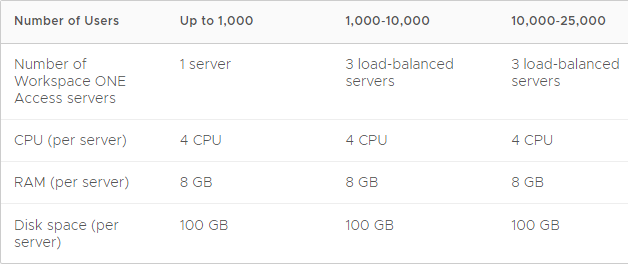
From Workspace ONE Access Architecture in the VMware Workspace ONE and VMware Horizon Reference Architecture:
Single data center:
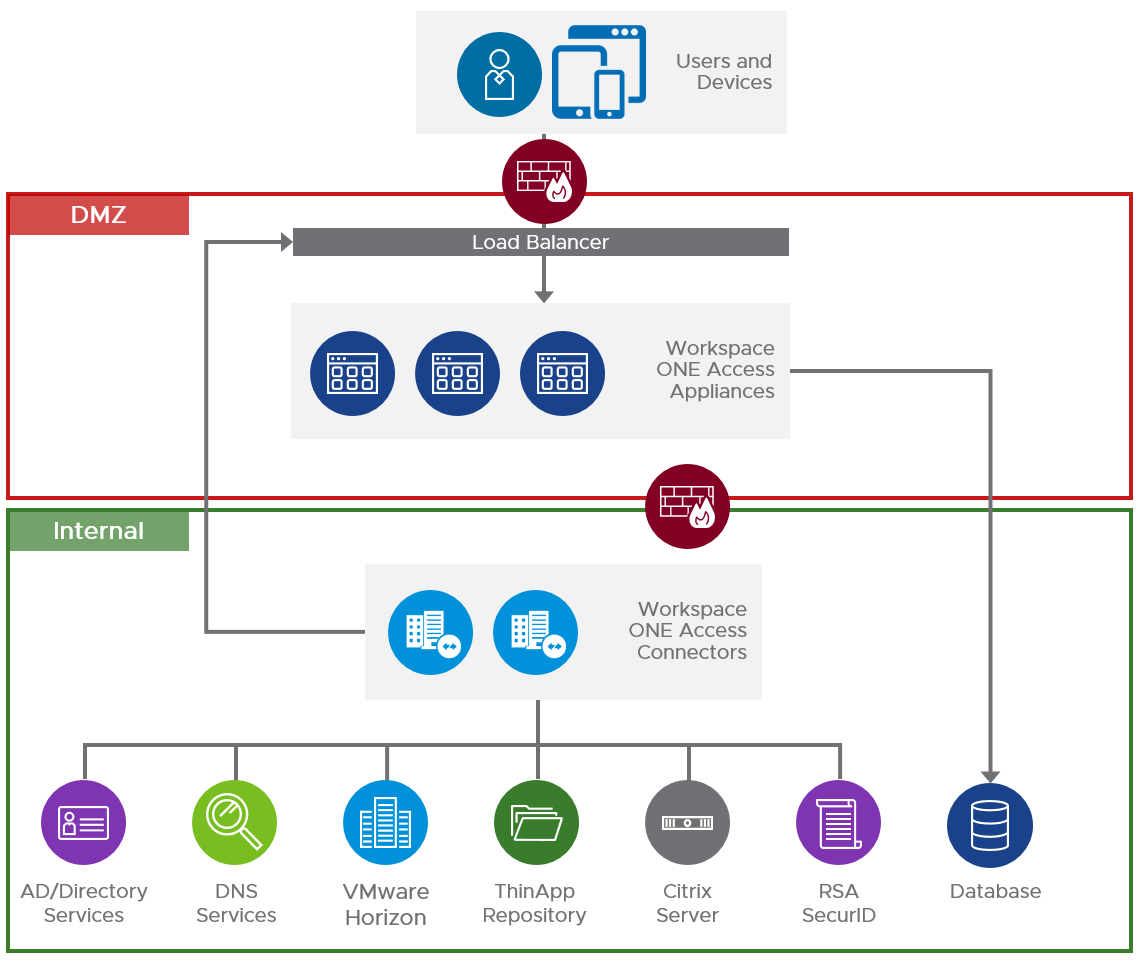
Multiple data centers:
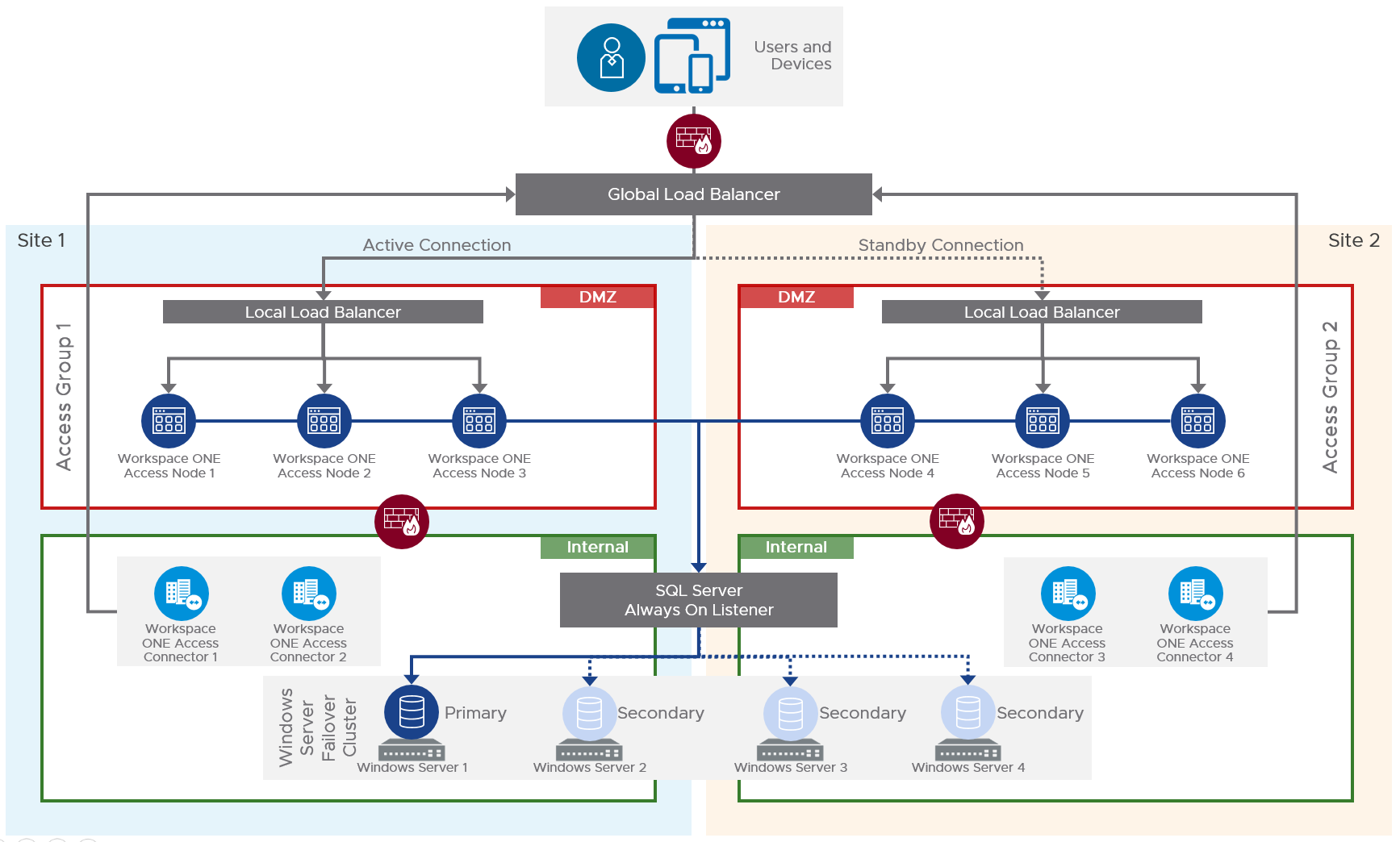
Outbound firewall requirements are detailed at VMware Docs.
Upgrade Appliance
Version 19.03 and newer no longer include the embedded Connector so you must deploy one or two Windows machines to run the external connector. The embedded Connector version 19.03 can be migrated to the external Windows Connector 23.09.
See Supported Upgrade Paths at VMware Docs:
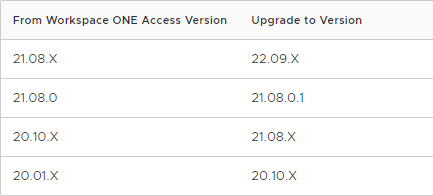

For clusters, remove all nodes except one from the load balancer and upgrade the node that is still connected to the load balancer. Then upgrade the remaining nodes.
If you have the older 19.03 Identity Manager Connectors, then see Migrating to VMware Workspace ONE Access Connector 22.09 at VMware Docs.
To upgrade an appliance:
- Ensure SQL is version 2014 or newer.
- Backup the database.
- Make sure the VMware Access SQL Service Account is a db_owner on the VMware Access database.
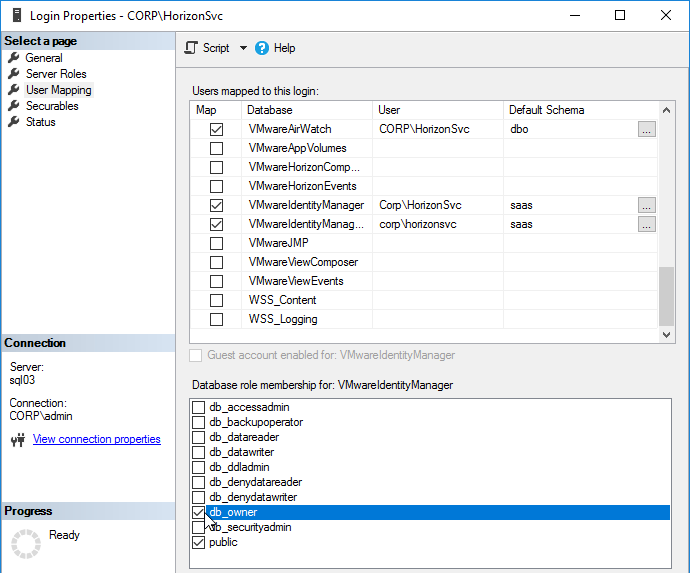
- In the Access admin console, go to Dashboard > System Diagnostics Dashboard to verify no issues with the appliance.
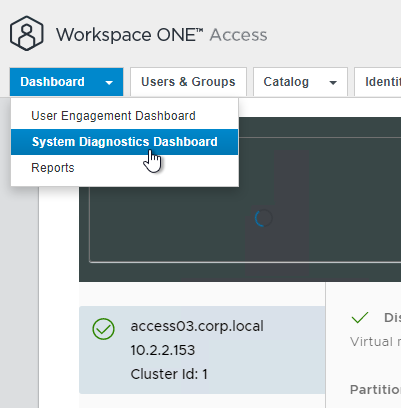
- SSH (e.g., Putty) to the appliance as sshuser and then run su to elevate to root user.
- Run df -h to verify at least 4 GB of free space on the / partition.
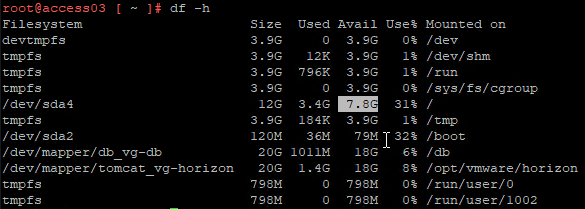
- For online updates, verify that the virtual appliance can resolve and reach vapp-updates.vmware.com on ports 80 and 443.
- If your appliance is version 21.08.0.1 (not 21.08.0.0), then download update-fix.tgz and install it as detailed at VMware Docs.
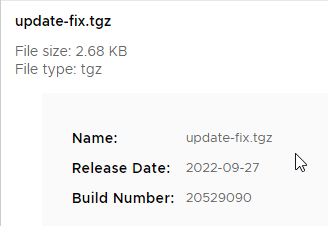

- Run /usr/local/horizon/update/updatemgr.hzn check to verify that an update is available.

- Snapshot the appliance.

- Run /usr/local/horizon/update/updatemgr.hzn updateinstaller

- Run /usr/local/horizon/update/updatemgr.hzn update. Updating will take several minutes.

- On the first node, enter y to perform a reindex. Enter n on other nodes.

- Reboot the VM when done.

- Upgrade log files are in the /opt/vmware/var/log directory, or https://WS1AccessHostnameFQDN:8443/cfg/logs
- Run the check command again to see if there are any other updates available.

- Repeat the upgrade on the remaining nodes.
- See Post-upgrade Configuration of Workspace ONE Access at VMware Docs to reinstall the provisioning adapters, refresh People Search Configuration, update Log4j Configuration Files, and fix Cluster ID in second data center
- Upgrade your Connectors to a version that is the same or older than the appliance. You might need a new es-config.json file to add support for Virtual Apps Collections.
- Before upgrading, suspend all the connector services at Integrations > Connectors > Manage
- RSA needs changes if upgrading from Connector 20.10 and older
New Deployment Preparation
DNS Configuration
If you intend to build multiple appliances (3 or more) and load balance them, specify a unique DNS name for each appliance. The Load Balancing DNS name is different from the appliance DNS names. For example:
- Appliance 1 = access01.corp.local
- Appliance 2 = access02.corp.local
- Appliance 3 = access03.corp.local
- Load Balancing Name = access.corp.com. This name is used both internally and externally.
VMware Workspace ONE Access DNS names are separate from Horizon DNS names.
You’ll need SSL certificates that match these names.
Each of these DNS names must have a corresponding reverse DNS pointer record.
- Create DNS records for the virtual appliances.
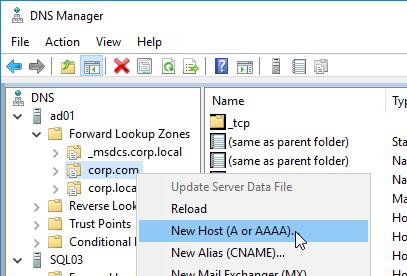
- Create reverse pointer records too. Reverse pointer records are required.
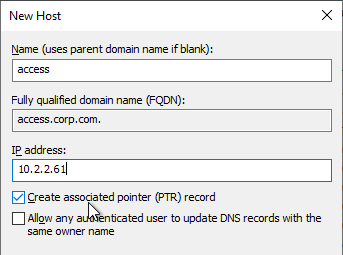
LDAP Accounts
- All accounts synced with VMware Workspace ONE Access must have First Name, Last Name, and E-mail Address configured, including the Bind account.
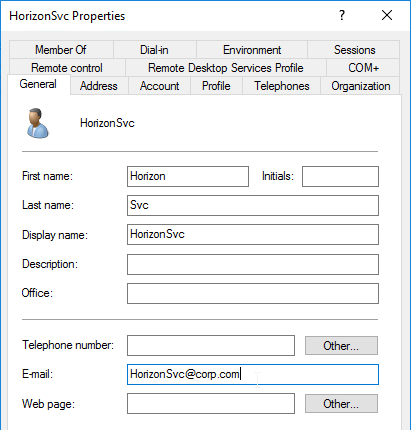
- Create a new Active Directory group for your VMware Workspace ONE Access users. Assign this group to your pools instead of assigning Domain Users.
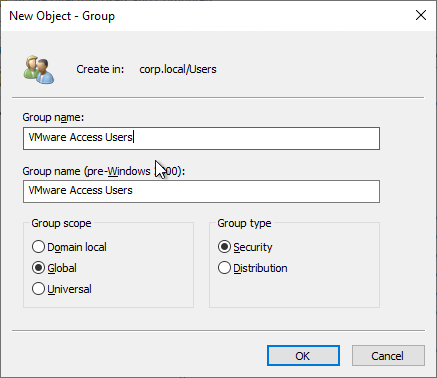
SQL Database
If you want to build multiple Identity Manager appliances and load balance them, configure them with an external database (e.g. Microsoft SQL).
For a script that performs all required SQL configuration, see Configure a Microsoft SQL Database at VMware Docs.
- In SQL Management Studio, create a New Query.

- Copy the SQL commands from VMware Docs and paste them into the New Query window.
- For Windows Authentication, copy the commands from Configure the Microsoft SQL Database with Windows Authentication Mode.
- For SQL Authentication, copy the commands from Configure Microsoft SQL Database Using Local SQL Server Authentication Mode.
- Change the values in the brackets and remove the brackets. Don’t forget the collation at the top of the script.
- Then click Execute.
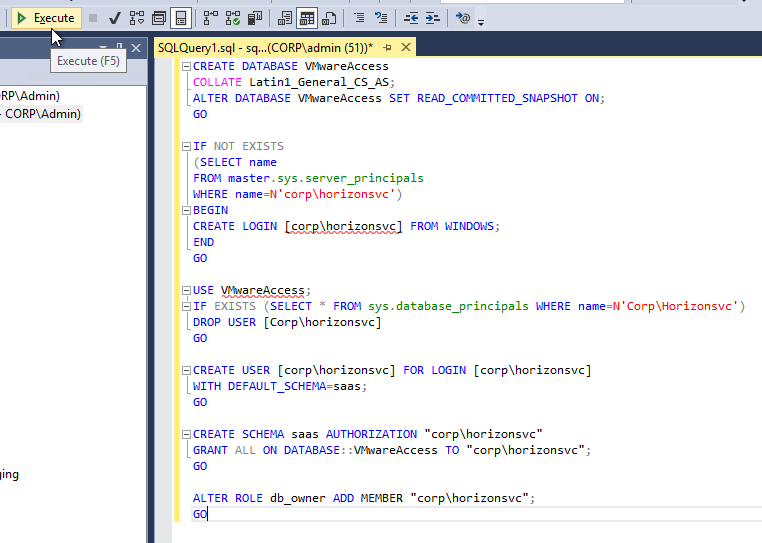
- Configure SQL Autogrowth to 128 MB as detailed at VMware Docs.

OVF Deployment
- Download the VMware Workspace ONE Access 23.09 Virtual Appliance OVA file.

- In the vSphere Web Client, right-click a cluster and click Deploy OVF Template.
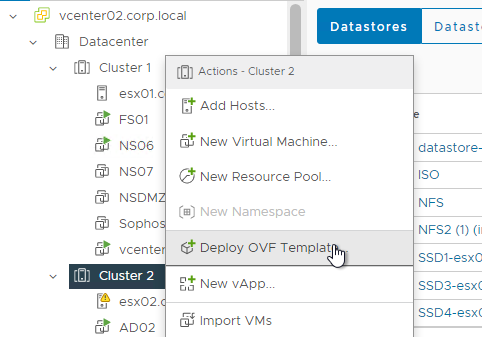
- In the Select source page, browse to the identity-manager-23.09.0.0_OVF10.ova file, and click Next.

- In the Select name and location page, enter a name for the VM, and click Next.
- In the Select a resource page, select a cluster, and click Next.
- In the Review details page, click Next.

- In the Accept License Agreements page, click Accept, and then click Next.
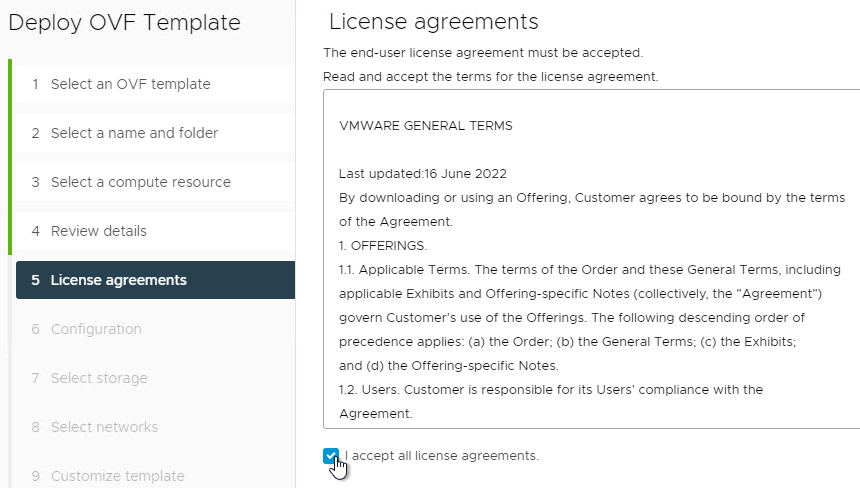
- In the Configuration page, select a size and click Next. 4 vCPU and 8 GB of RAM are sufficient for 25,000 users.
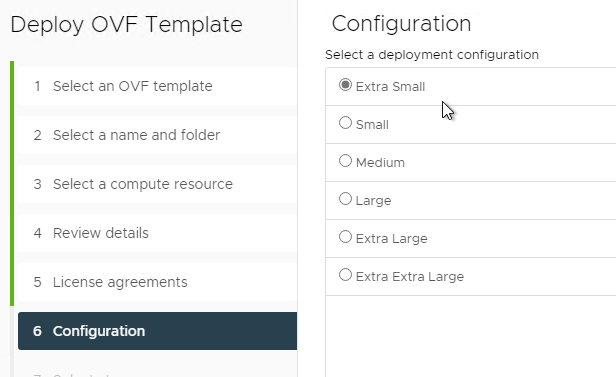
- In the Select storage page, select Thin Provision, select a datastore, and click Next.
- In the Select networks page, select the network for the appliance. You can deploy it either internally, or in the DMZ. If in the DMZ, you can later install Workspace ONE Access Connectors in the internal network in outbound only mode. Click Next.
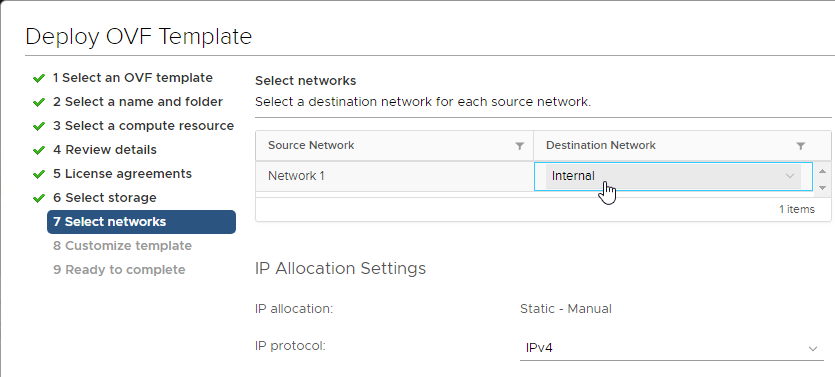
- In the Customize template page:
- Select a time zone.
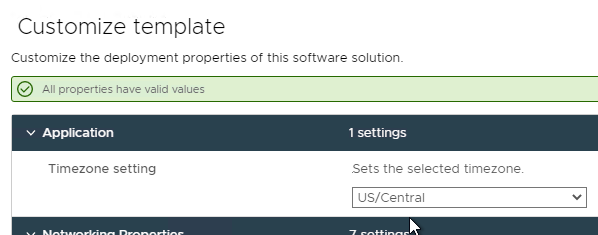
- Expand Networking Properties if it’s not already expanded.
- Host Name – Enter a hostname for the first appliance.
- If you intend to build multiple appliances and load balance them, then each appliance needs a unique name that does not match the load balanced name. If you only want to build one appliance, then the appliance Host Name should match whatever users will use to access Identity Manager.
- DNS and Gateway – In the Networking Properties section, enter the standard DNS and Gateway information.

- According to Install the Workspace ONE Access OVA File at VMware Docs, the Domain Name and Domain Search Path fields are not used.

- IP Address – Enter the IP address that is configured in DNS for the host name. DNS reverse lookup for this IP address must resolve to the appliance Host Name.
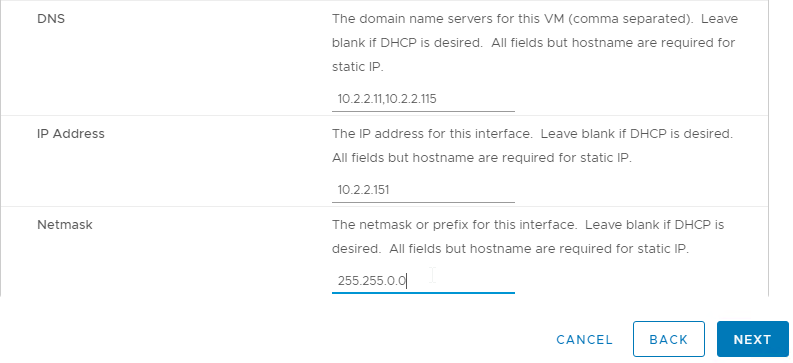
- Select a time zone.
- Click Next.
- In the Ready to complete page, click Finish.
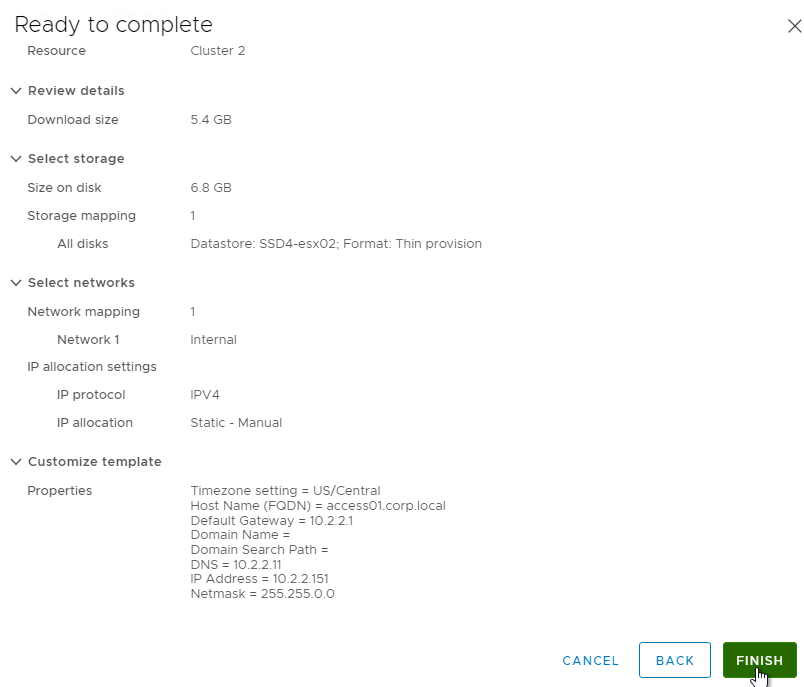
Setup Wizard
- Power on the appliance.
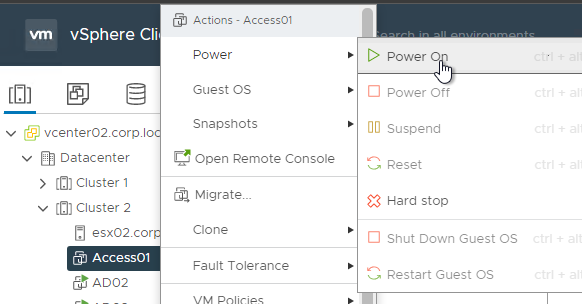
- Wait for the appliance to power on and fully boot.
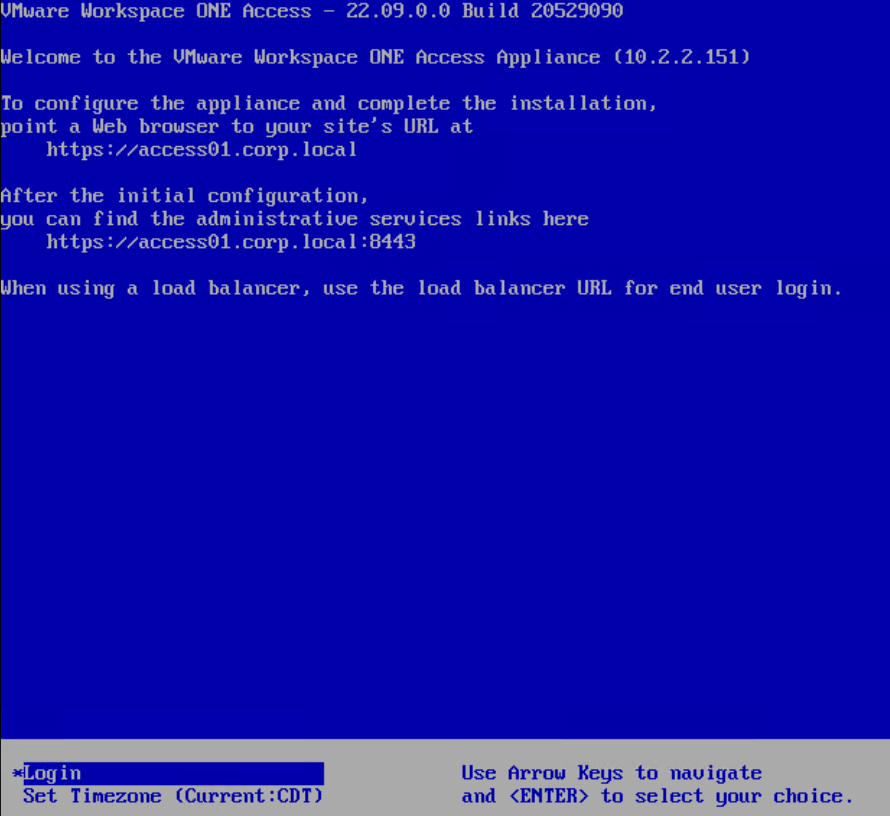
- Go to https://myAccessFQDN to access the Access Setup Wizard.
You must connect to the DNS name. Connecting to the IP address will cause problems during the database setup process.
- In the Set Passwords page, enter passwords for the three accounts and click Continue. Notice that two of the passwords must be 14 characters or longer.
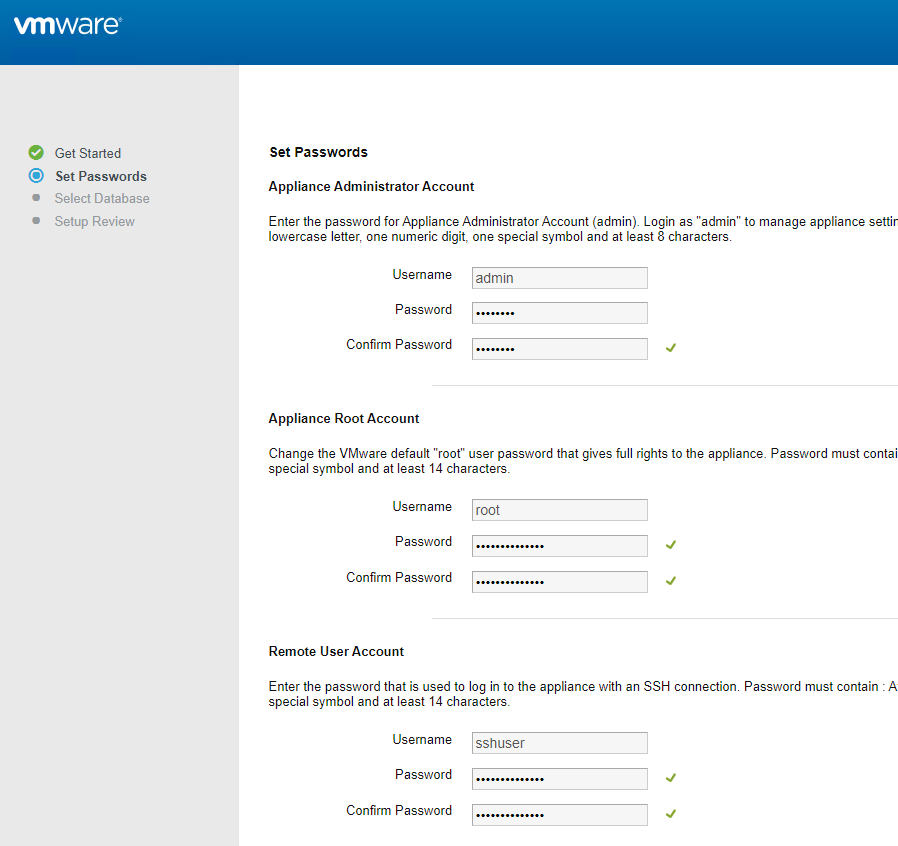
- In the Select Database page, change it to External Database.
 Note: this page will only function properly if your address bar has a DNS name instead of an IP address.
Note: this page will only function properly if your address bar has a DNS name instead of an IP address. - For Windows authentication, enter a JDBC URL similar to the following (VMware Docs), enter credentials for the Horizon Windows service account, and then click Continue. The connection string changed in version 22.09.
jdbc:sqlserver://sql03.corp.local:1533;DatabaseName=VMwareAccess;integratedSecurity=true;authenticationScheme=NTLM;domain=corp
- For SQL authentication, enter a JDBC URL similar to the following, enter the credentials for the Horizon SQL account, and then click Continue. Access 21.08 and newer has an option to encrypt the database connection.
jdbc:sqlserver://mysqlserver.corp.local;DatabaseName=saas;multiSubnetFailover=true

- The database will be configured.
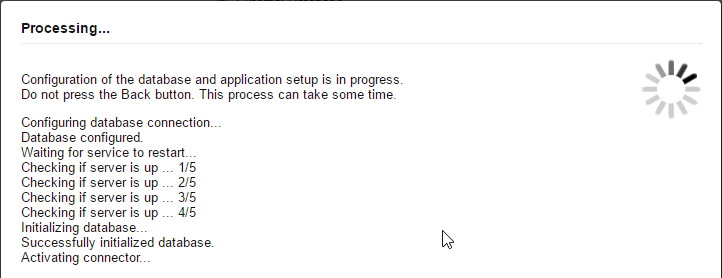
- In the Setup Review page, click the link to log in to the Admin Console.
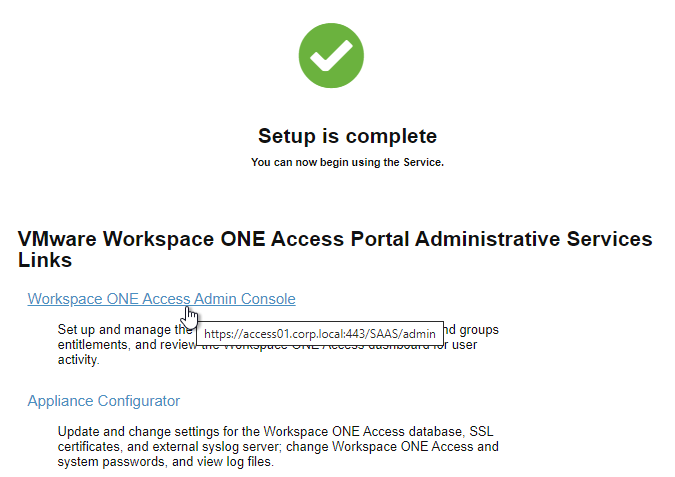
SSH – Enable Root Access
This is optional. Enabling root access lets you use root credentials when using WinSCP to connect to the appliance.
- Putty to the VMware Workspace ONE Access appliance.
- Login as sshuser.
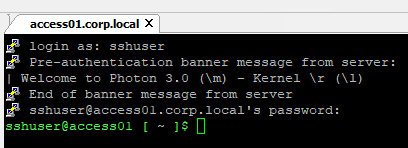
- Run su – and enter the root password.

- Run
vi /etc/ssh/sshd_config.

- Scroll down to line containing PermitRootLogin.
- Press <i> on the keyboard to change to insert mode.
- Go to the end of the line and change no to yes.

- Press <ESC> to exit insert mode.
- Type
:xto save the file and exit.
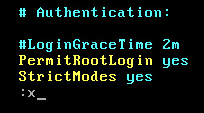
- Run
systemctl restart sshd.

VMware Access Certificate
The Windows Connectors require the VMware Access certificate to be trusted. Generate a new appliance certificate using a trusted Certificate Authority and install the certificate on the appliance.
- Login to the Identity Manager web page as the admin user in the System Domain.
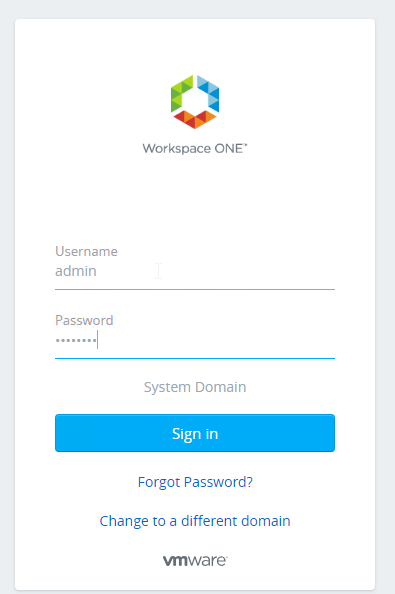
- Click Monitor and then click Resiliency.
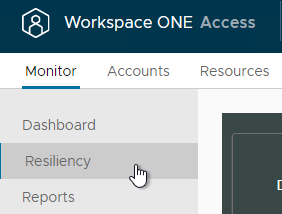
- Click the VA Configuration button next to the appliance name.

- On the left, click the page named Install SSL Certificates.
- On the right, click Choose File next to Import Certificate File.
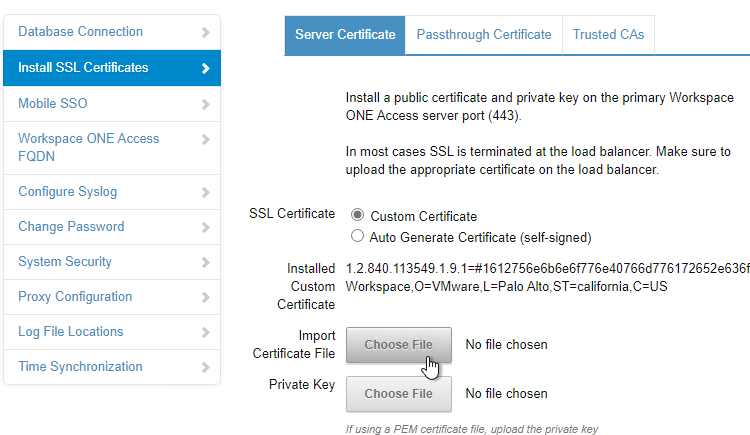
- .pfx files are supported.
- In the Password field, enter the .pfx password.
- Click Save.
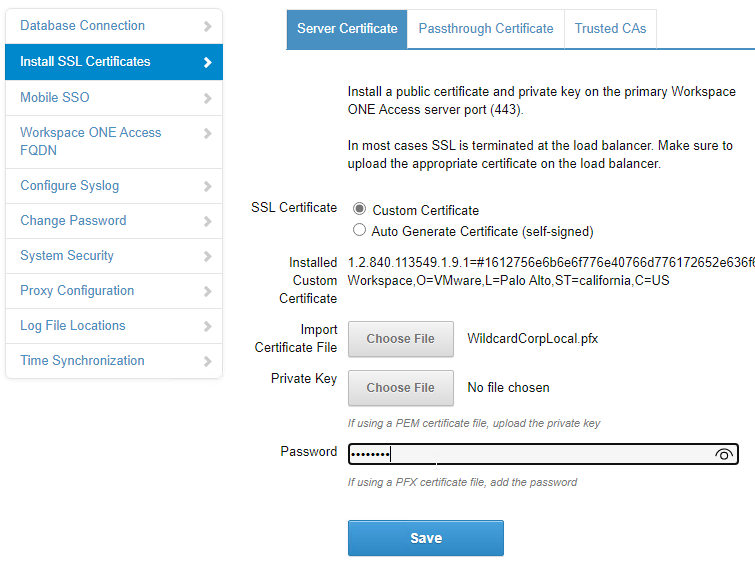
- It will take several minutes for the certificate to be installed and the appliance to restart.
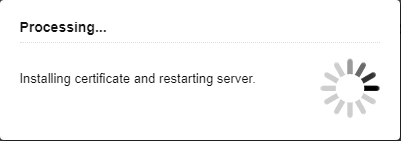
Load Balancing
VMware Access can be cloned, clustered, load balanced, and globally load balanced as shown below. Source = Multi-site Design in the Workspace ONE Access Architecture.
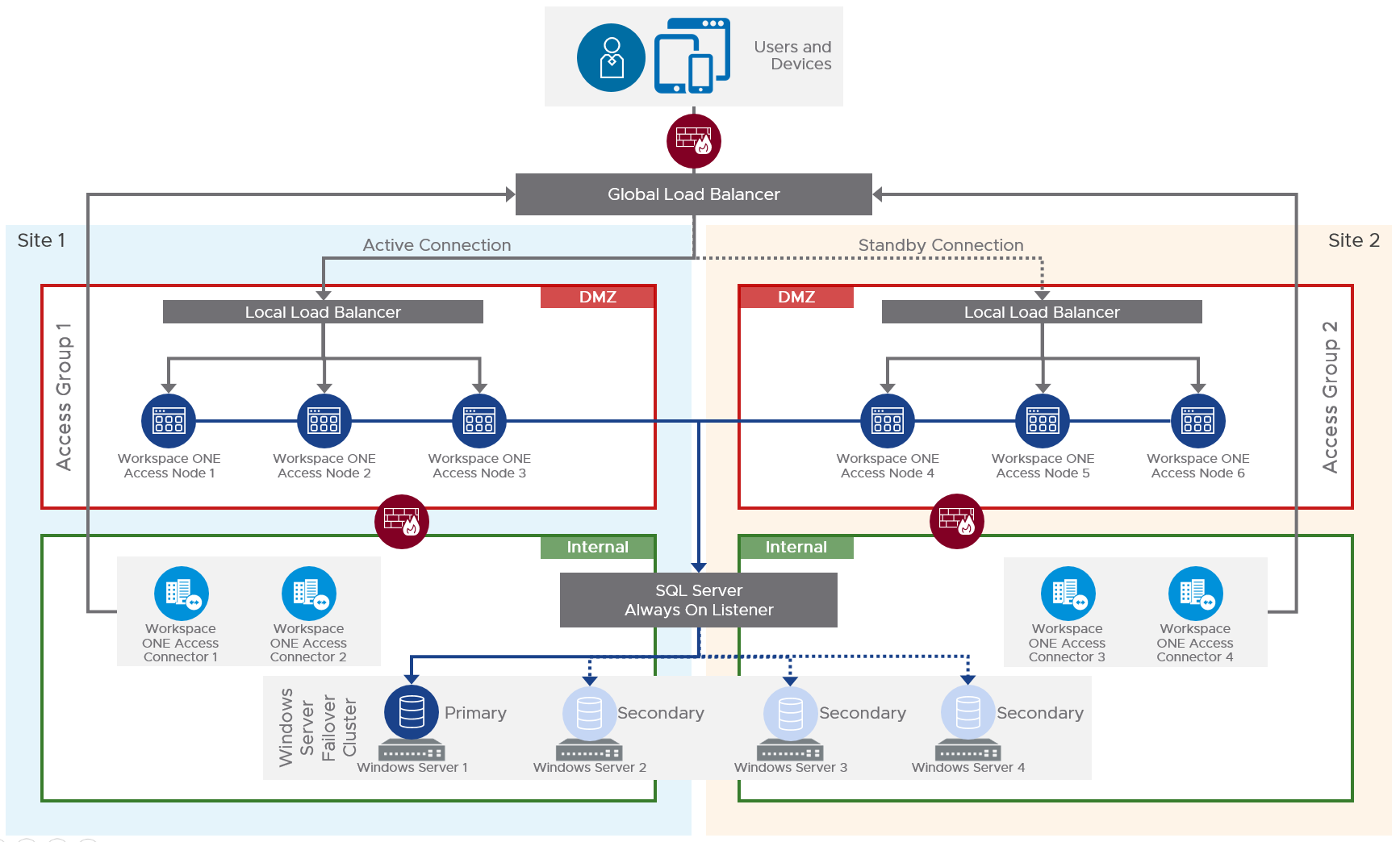
To clone multiple VMware Access appliances and load balance them, see one of the following:
- For Citrix ADC load balancing of VMware Access, see https://www.carlstalhood.com/VMware-Identity-Manager-Load-Balancing
- For F5 load balancing of Identity Manager, see EUC CST Tech Notes – IDM Steps by steps 3 node cluster – v4.pdf at VMware Communities
Windows Connector
All VMware Access Connectors are Windows Servers.
VMware Access supports Connectors that are the same version or older than the VMware Access appliance.
A Connector with 4 vCPU and 8 GB RAM supports 100,000 users.
- Load balance your VMware Access appliances so the Connector can connect to the Load Balanced FQDN instead of a single VMware Access appliance.
- Build one or more Windows machines on the internal network that will host the Windows connector. The Windows machines must be joined to the domain.
- Windows Server 2019 is supported in Connector 21.08 and newer.
- Windows Server 2022 is supported by Connector 22.09.1 but not by Connector 22.09.
- See System Requirements at VMware Docs for sizing information.
- Connector Firewall requirements at VMware Docs.
- For multi-data center, build separate Connectors for each data center. The Connectors connect to the VMware Access appliances in the local data center. For details, see Deploying VMware Workspace ONE Access in a Secondary Data Center for Failover and Redundancy at VMware Docs.
- The VMware Access certificate must be trusted by the Connector servers.
- Login to the VMware Access administration console through the load balanced FQDN as the admin user in the System Domain.

- In 22.09 and newer, go to Integrations > Connectors and click New.
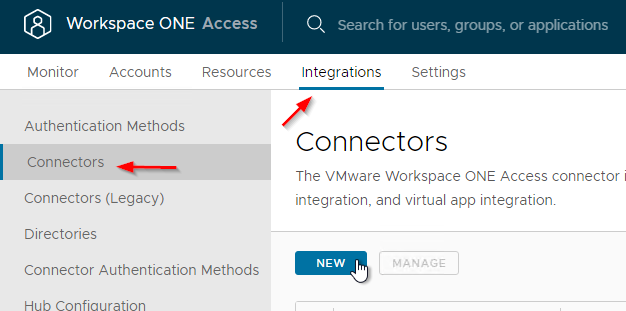
- In older Access:
- On the top tabs, switch to Identity & Access Management.
- On the sub-menu bar, on the far right, click Setup.
- On the sub-menu bar, on the left, click Connectors.
- Click the blue NEW button.

- In the Select the Connector page, select the Latest Workspace ONE Access Connector and click OK.
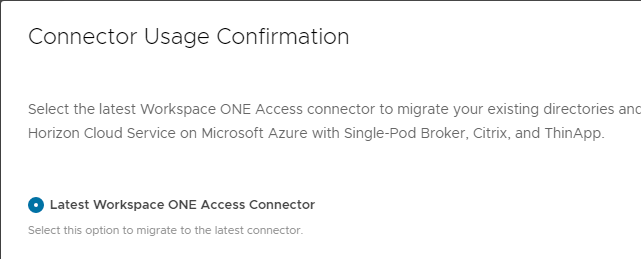
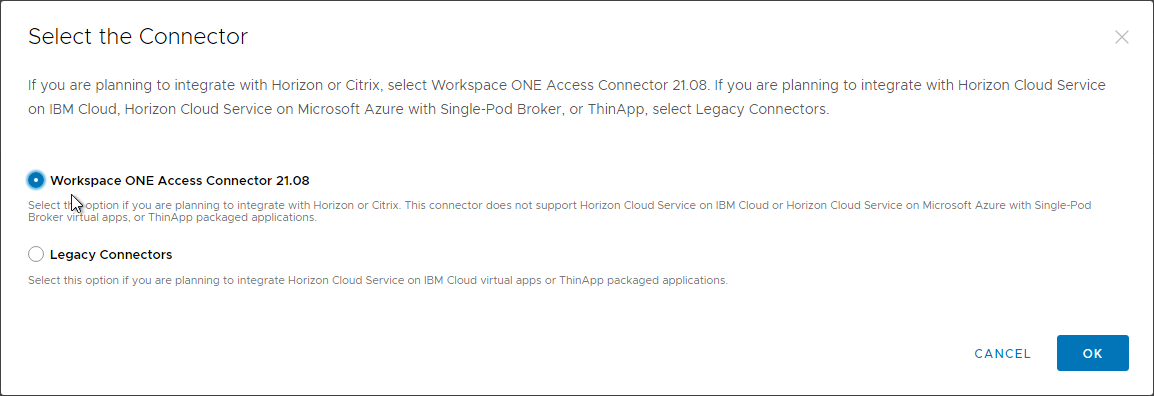
- Click Confirm.

- In the Download Installer page, click the button to Go to myvmware.com and download the connector installer if you haven’t downloaded it already. Then click Next.
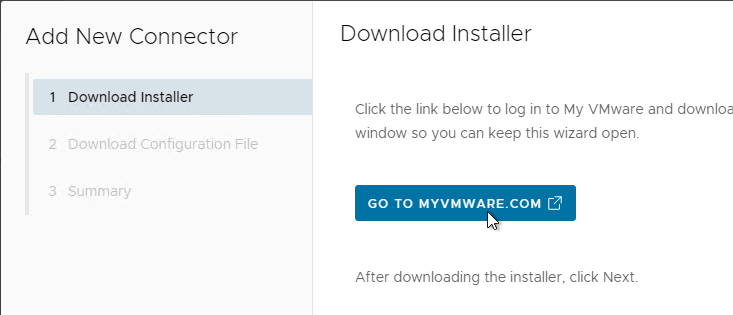
- In the Download Configuration File page, enter a 14-character password, click Download Configuration File, and save it somewhere. Then click Next.
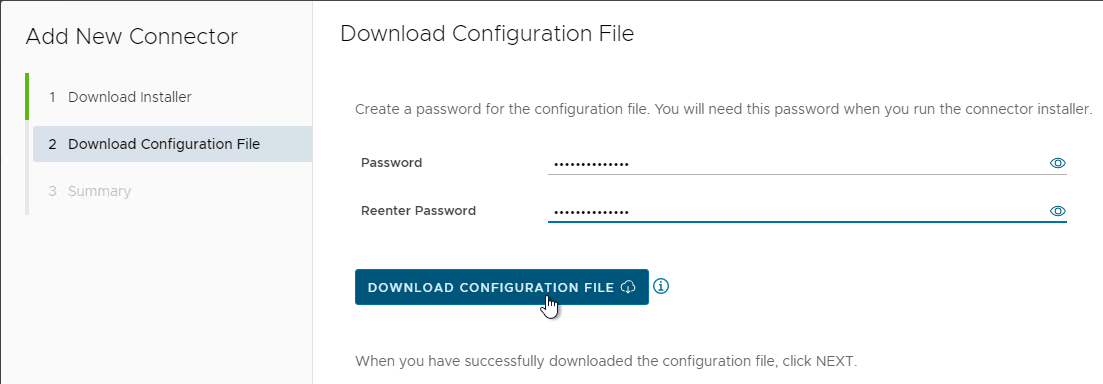
- In the Summary page, click Close.

- See Workspace ONE Access Connector Systems Requirements at VMware Docs for sizing guidelines. For example, installing all components on a single server requires 12 GB of RAM.
- On the Windows machine, run Workspace-ONE-Access-Connector-Installer-22.09.1.0.exe.

- Click Install to install .NET Framework 4.8.
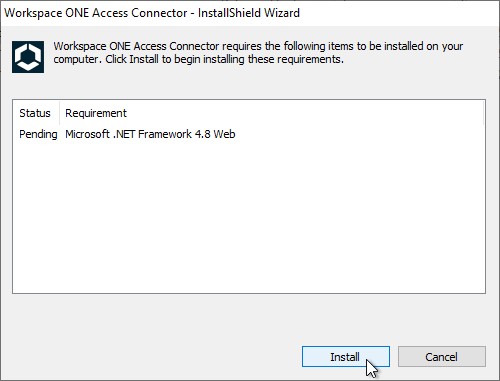
- Click Yes to restart.
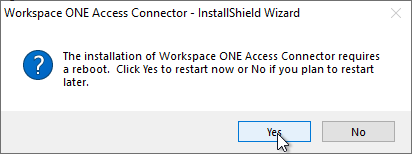
- The Connector installer should automatically launch again. If not, you can launch it manually.
- In the Welcome to the Installation Wizard for Workspace ONE Access Connector page, click Next.
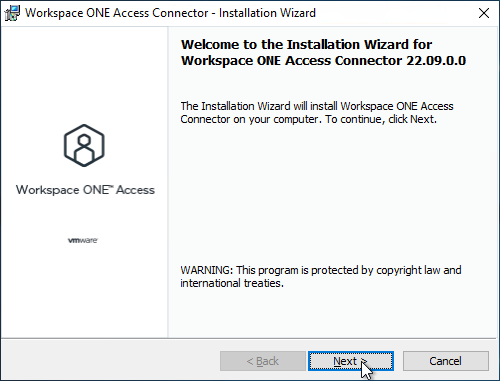
- In the License Agreement page, click I accept the terms, and then click Next.
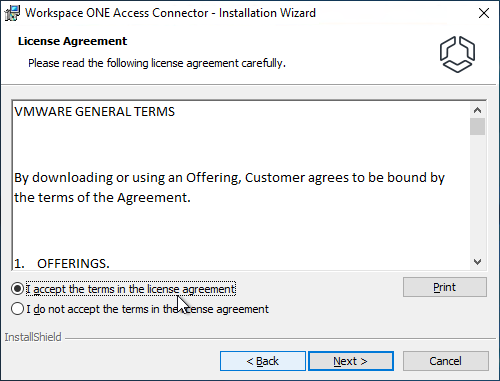
- In the Service Selection page, click Next.
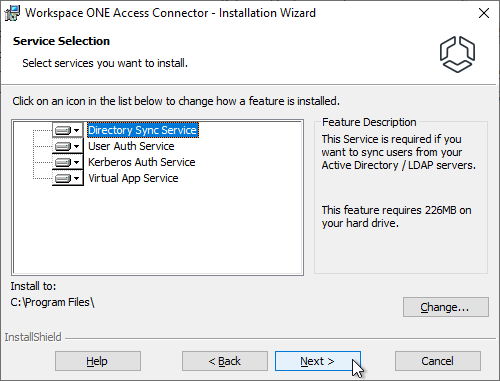
- In the Specify configuration file page, browse to the es-config.json file downloaded earlier and then click Next.
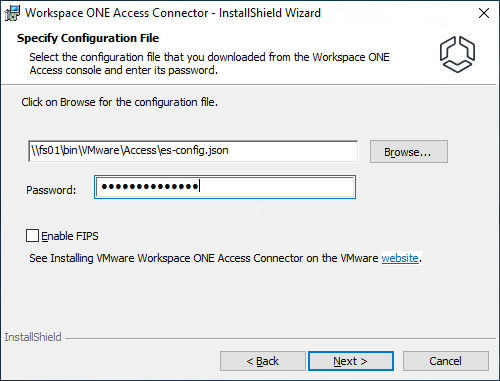
- In the Select Default or Custom Installation page, choose Custom and then click Next.
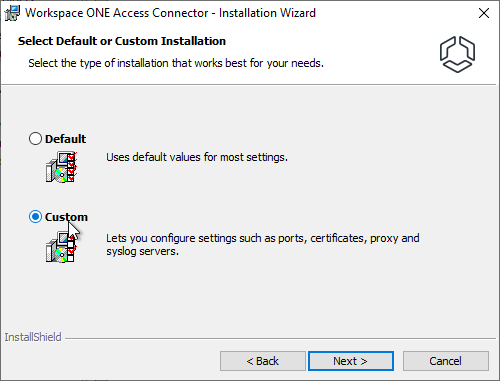
- In the Specify Proxy Server Information page, click Next.
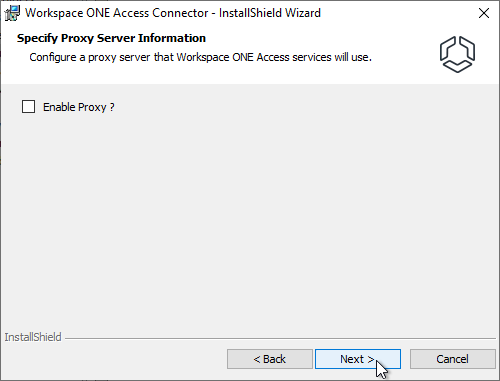
- In the Specify Syslog Server Information page, click Next.
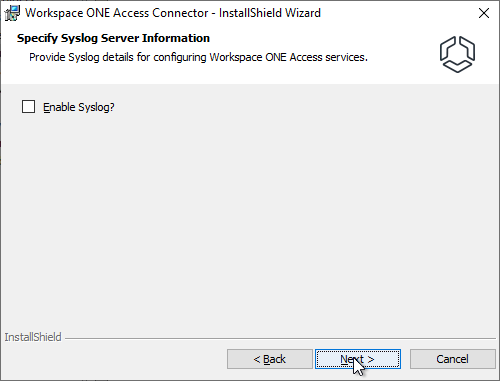
- In the Citrix Configuration page, click Next.
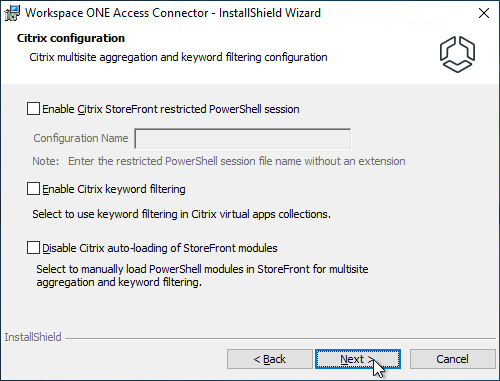
- In the Install Trusted Root Certificates page, click Browse and upload your CA and Intermediate certificates that signed the VMware Access certificate. Java uses different root certificates than Windows so you’ll need to upload them here so Java can use them. Click Next.
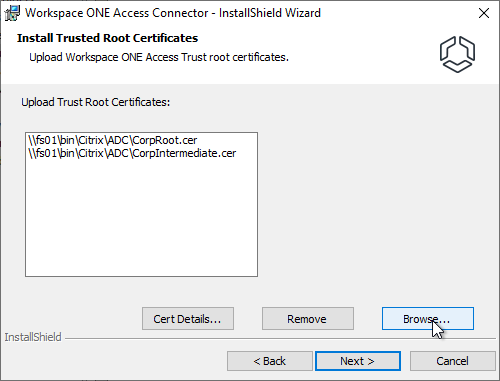
- In the Specify Ports page, click Next.
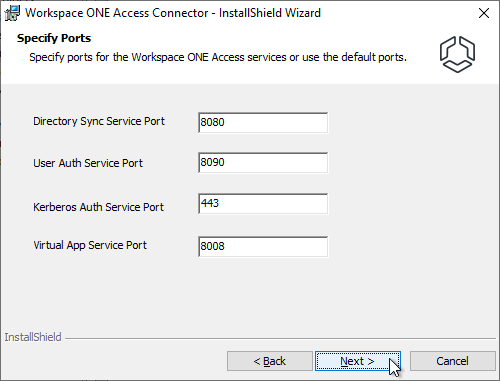
- If you are installing the Kerberos Auth Service, then select a .pfx certificate that clients will trust and click Next.
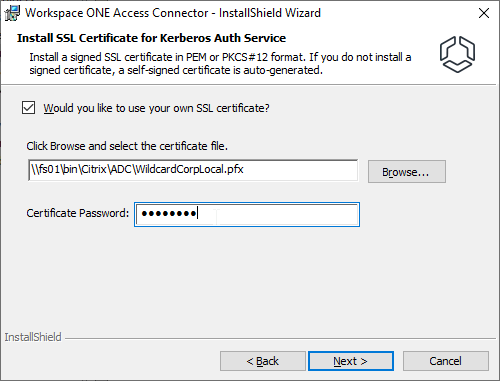
- In the Specify Service Account page, enter service account credentials and then click Next.
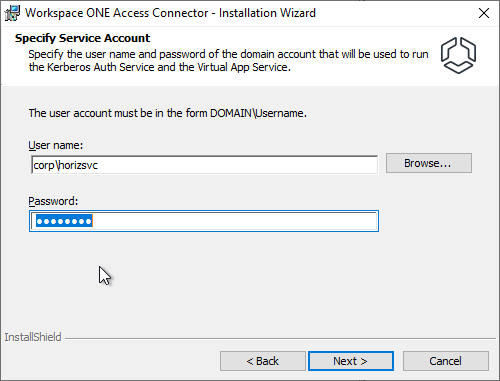
- The service account must be added to the local Administrators group.
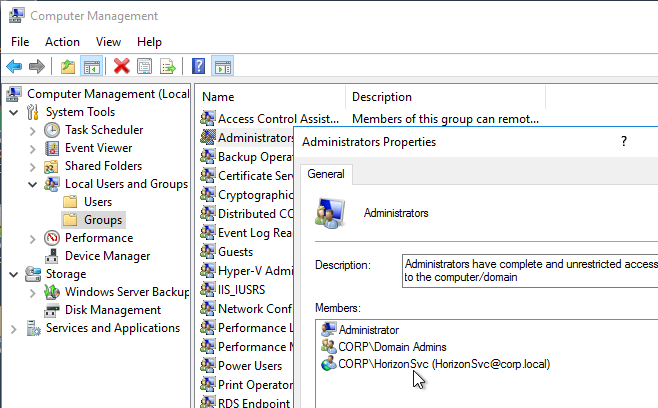
- The service account must be added to the local Administrators group.
- In the Ready to Install the Program page, click Install.
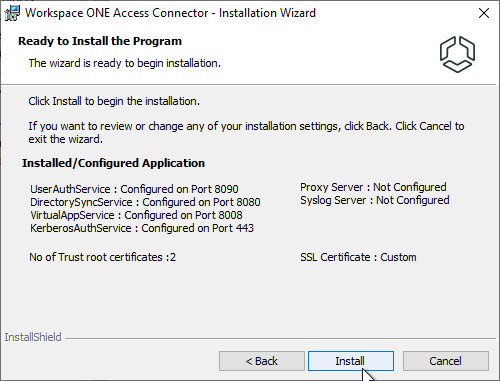
- In the Installation Wizard Completed page, click Finish
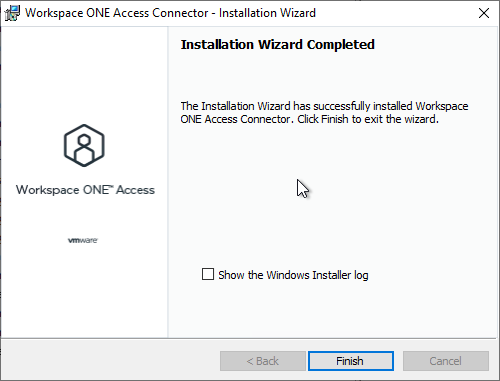
- In VMware Access, go to Integrations > Connectors to see the new Connector. If you don’t see it, then check C:\Program Files\Workspace ONE Access\Virtual App Service\logs\eis-service.log on the Connector server.
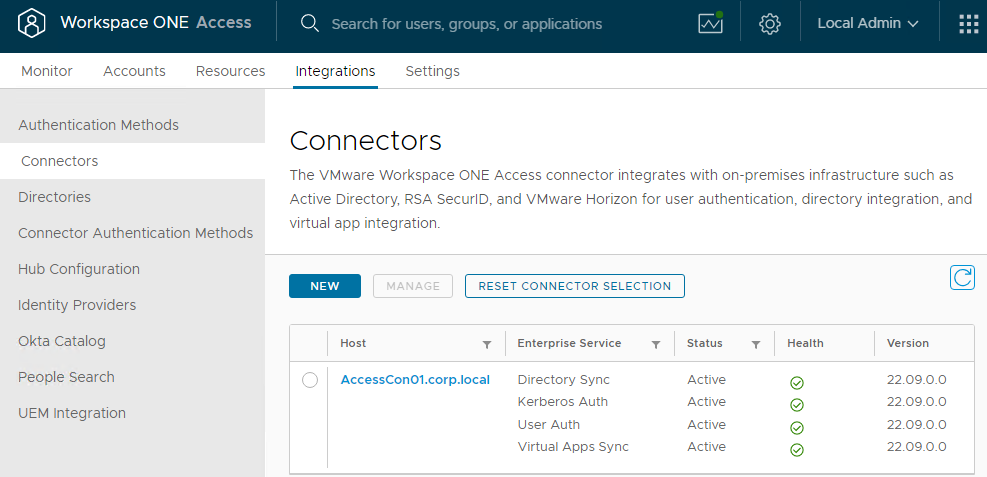
- Repeat these steps to add another connector. You can use the same es-config.json file.
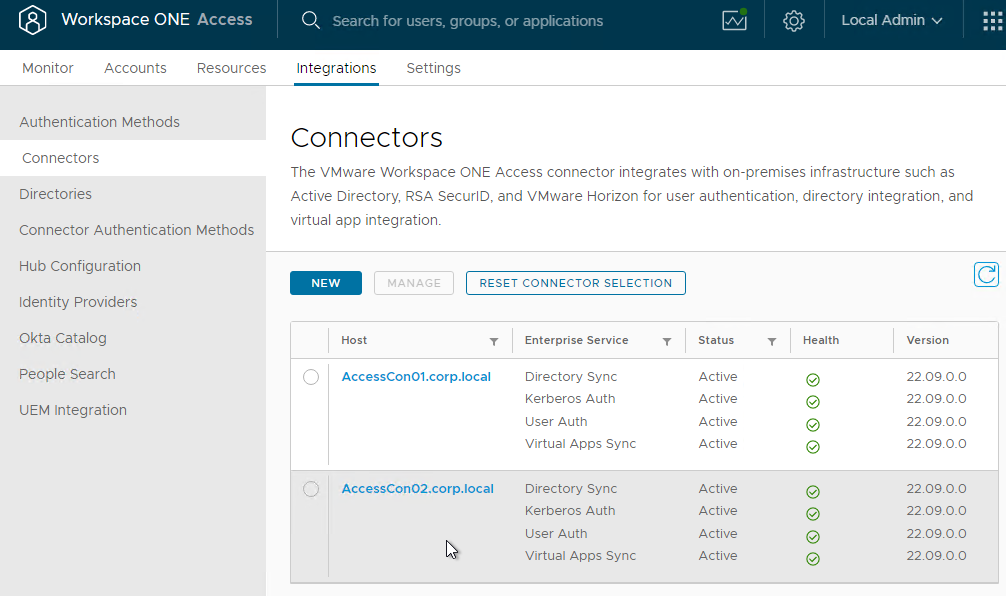
Configuration
Active Directory
- Login to the VMware Access web page as the admin user in the System Domain.

- In 22.09 and newer, go to Settings > User Attributes.
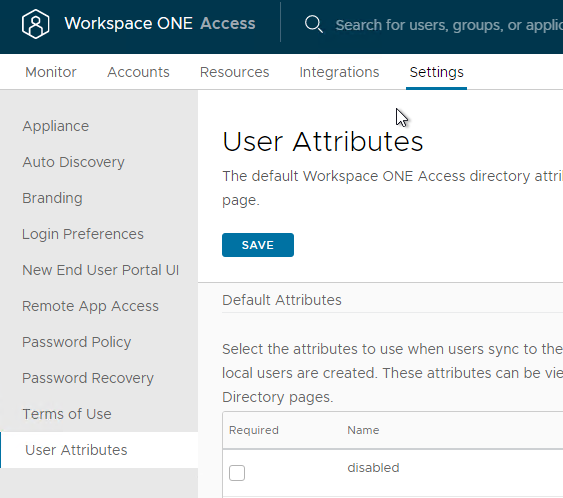
- In older VMware Access, switch to the Identity & Access Management tab.

- On the top right, switch to the Setup view.
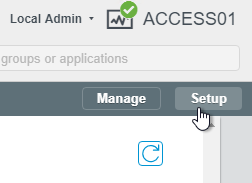
- On the left, switch to the User Attributes sub-tab.

- In older VMware Access, switch to the Identity & Access Management tab.
- In the Default Attributes section, check the boxes next to distinguishedName and userPrincipalName. These are needed for Horizon.
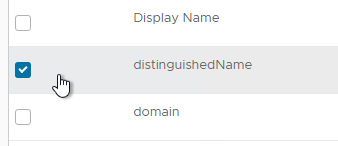
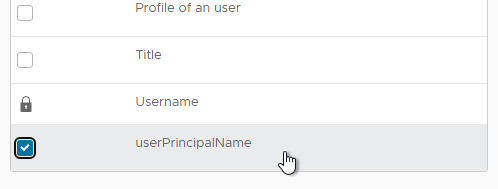
- In the Custom Attributes section, click Add Row and enter objectGUID.
- Add another row and enter mS-DS-ConsistencyGuid. These are needed for Office 365 integration.
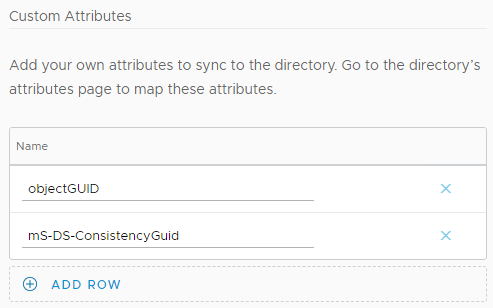
- In older VMware Access, in the Add other attributes to use section, click the plus icon and enter objectGUID.

- Click the green plus and add mS-DS-ConsistencyGuid. These are needed for Office 365 integration.

- In older VMware Access, in the Add other attributes to use section, click the plus icon and enter objectGUID.
- At the top of the page, click Save.
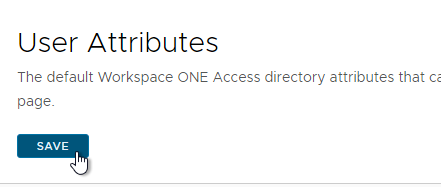
- In 22.09 and newer, go to Integrations > Directories and click Add Directory > Active Directory at the top right of the page.
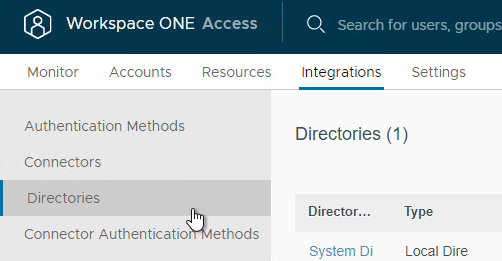
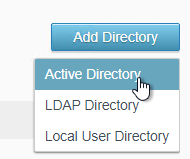
- In older VMware Access, on the top right, switch to the Manage view.
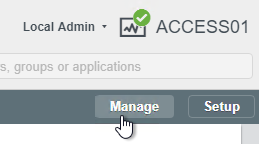
- On the Directories tab, click Add Directory > Active Directory.

- In older VMware Access, on the top right, switch to the Manage view.
- Enter a Directory Name.
- Change it to Active Directory over integrated Windows Authentication.

- Select one or more Connectors as Directory Sync Hosts and User Auth Hosts.
- Select which attribute users should enter as their User Name.
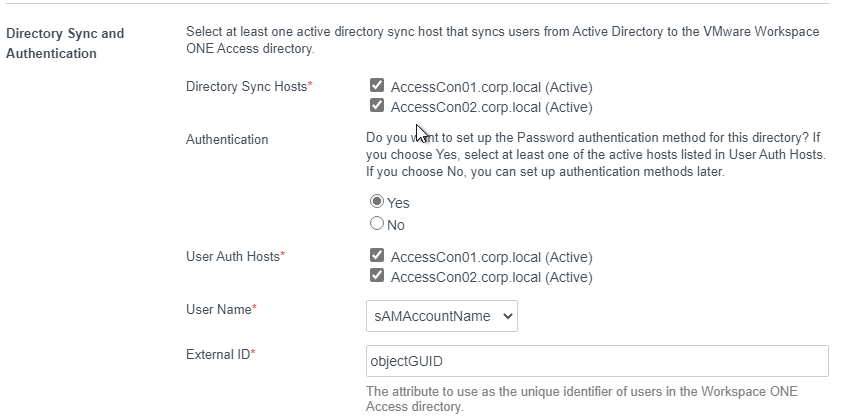
- Scroll down.
- Enter the LDAP Bind credentials. Click Save & Next.

- Select the domains you want to sync and click Next.
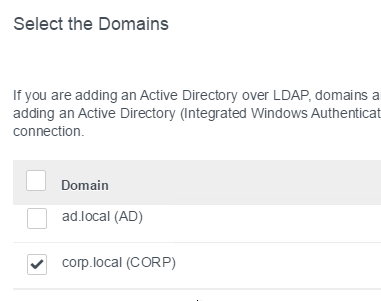
- In the Map User Attributes page, scroll down, enter Active Directory attribute names for any missing attribute, and click Next.
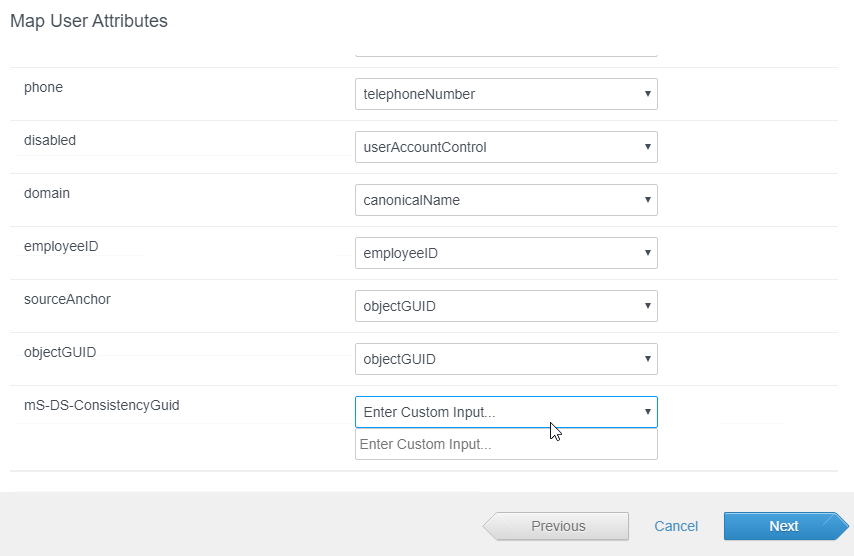
- In the Select the Groups page, click the plus icon to add a DN.

- Enter a Base DN in LDAP format and then click Select Groups.

- Search for your Access Users group, select it, and click Save.

- Click Next.
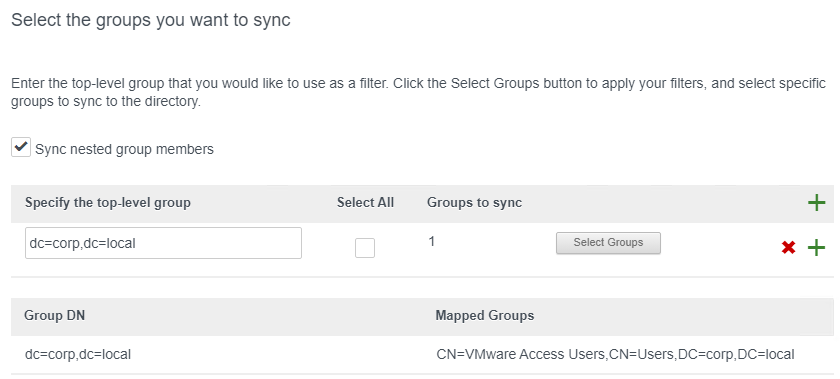
- In the Select the Users page, click Next.
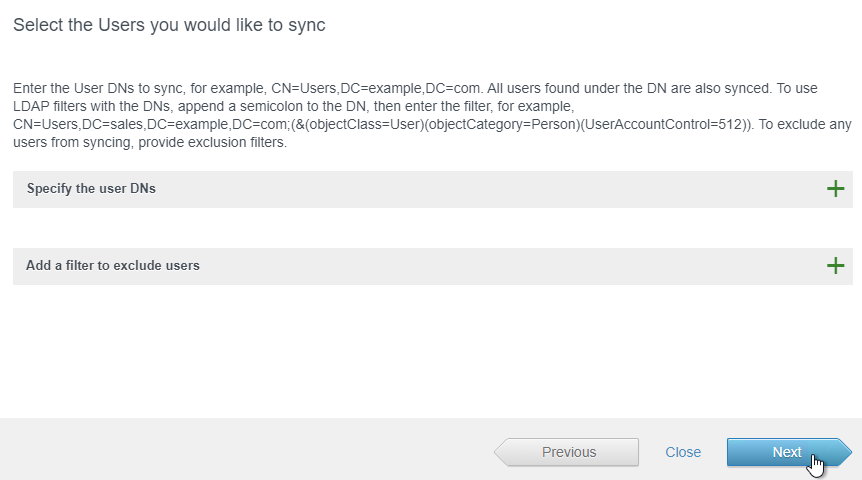
- In the Sync Frequency field, make a selection and then click Sync Directory.
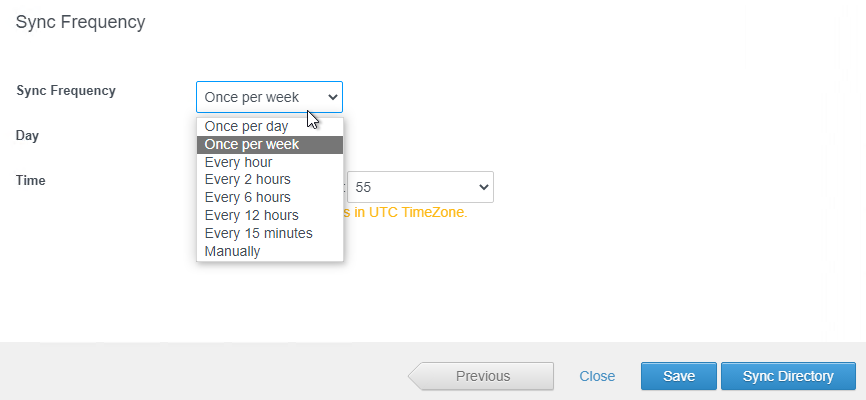
- You can click the link to view the Sync log.

- Or from the main directories list, you can click the directory name, and then click the tab named Sync log to view the log.
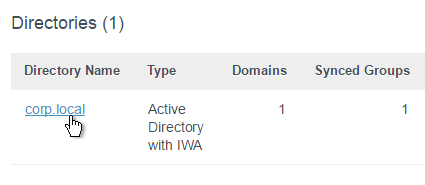
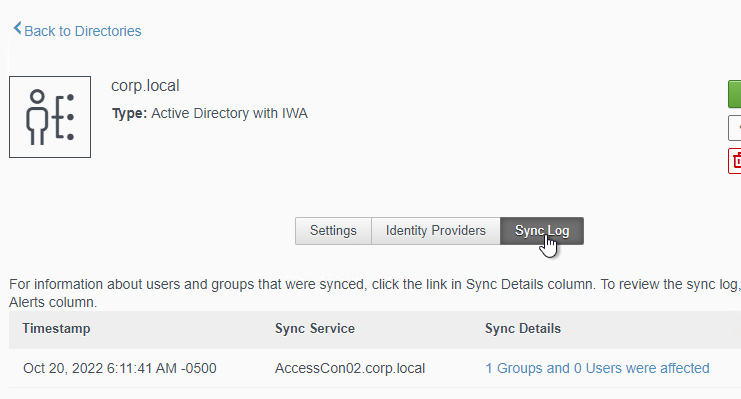
- Sync Settings can be changed by clicking the button on the right.

Sync Connector Redundancy
If you build another Windows Connector, you can add it to the Directory as another Sync Service.
- In VMware Access 22.09 and newer, at Integrations > Directories, click the directory.
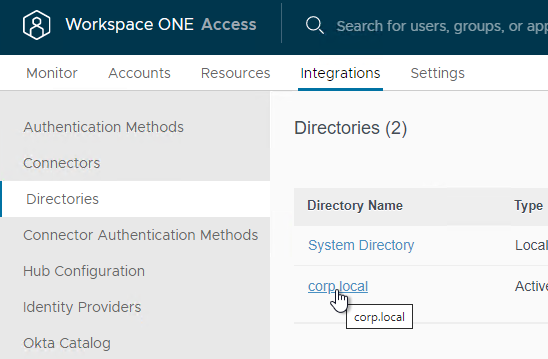
- Or in older VMware Access, in the VMware Access console, in the Identity & Access Management page, on the left, click the Directories link.

- Click the link for your Active Directory domain.
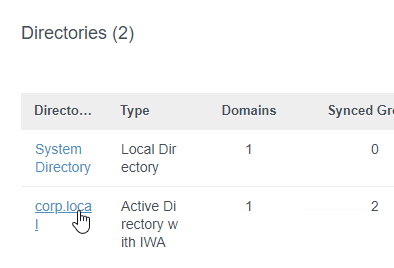
- Or in older VMware Access, in the VMware Access console, in the Identity & Access Management page, on the left, click the Directories link.
- On the right, click the Sync Settings button.
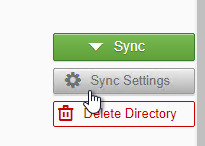
- Switch to the Sync Service tab.
- Select the new connector and click the plus icon to move it to the bottom.
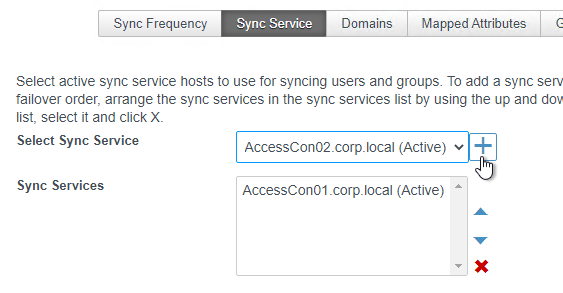
- You can order the connectors in failover order. Click Save.
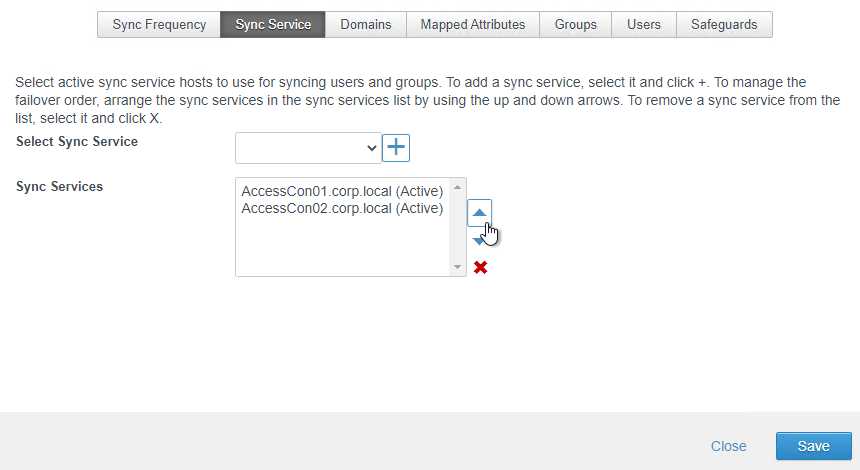
Sync Group Membership
By default, VMware Access does not synchronize group members. You can force a sync.
- In VMware Access 22.09 and newer, go to Accounts > User Groups.
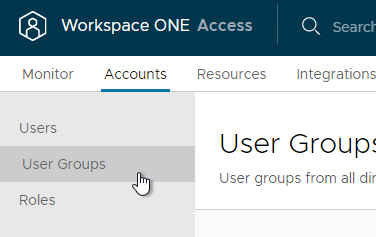
- In older VMware Access, go to Users & Groups > Groups.
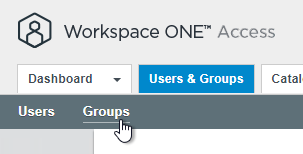
- In older VMware Access, go to Users & Groups > Groups.
- Notice that the groups are Not Synced. Click the link for a group.

- Switch to the Users tab. Then click the Sync Users button.
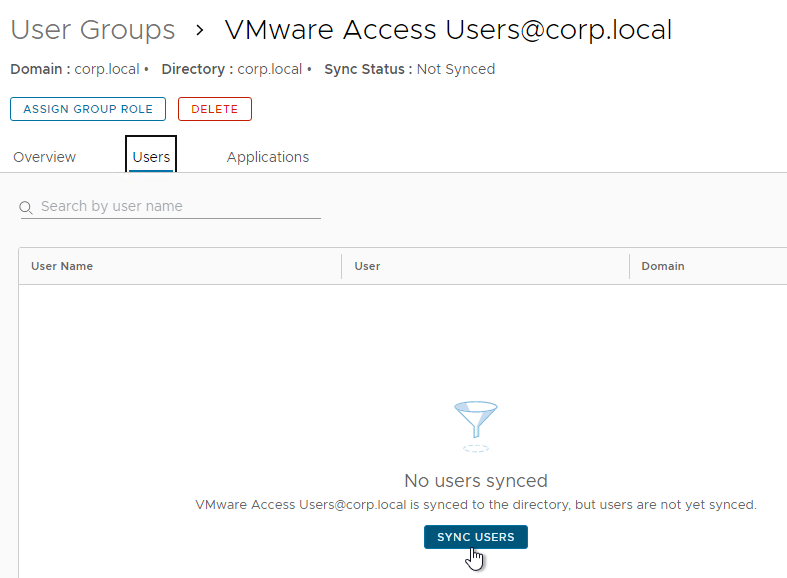
Logon Experience
- In VMware Access 22.09 and newer, go to Settings > Login Preferences and click Edit.
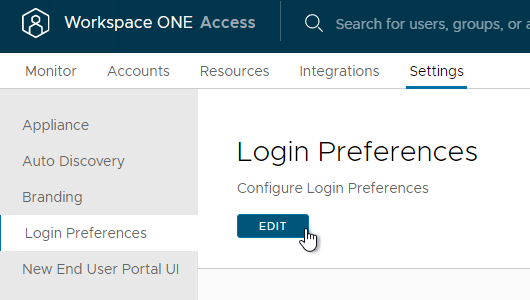
- Or in older VMware Access, go to Identity & Access Management > Setup > Preferences.

- Or in older VMware Access, go to Identity & Access Management > Setup > Preferences.
- On the bottom, you can optionally hide the Domain Drop-Down menu. Then select the unique identifier that Identity Manager will use to find the user’s domain (typically UPN if multiple domains). VMware Access can show a Domain Drop-Down if a unique domain cannot be identified.
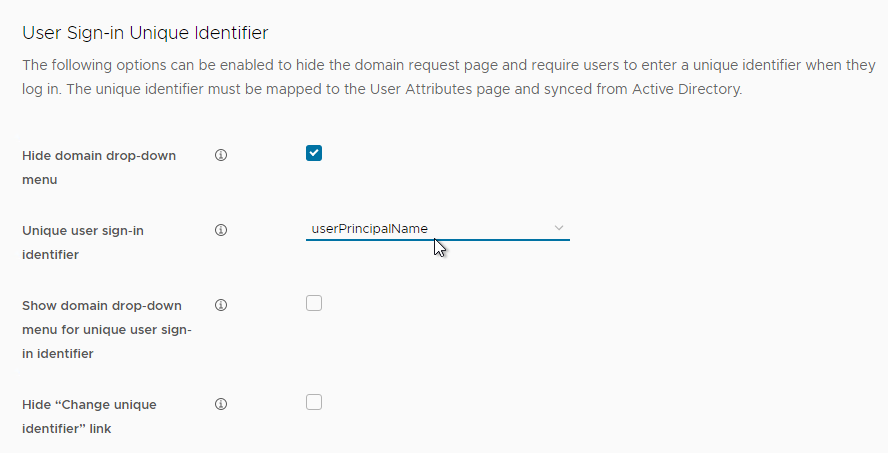
- The user will be prompted to enter the unique identifier.
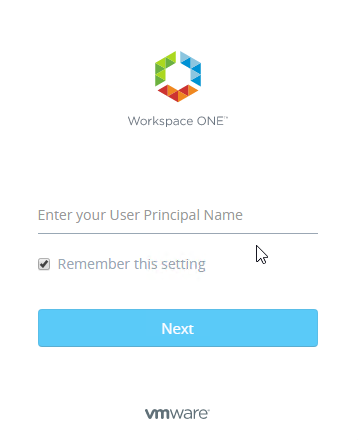
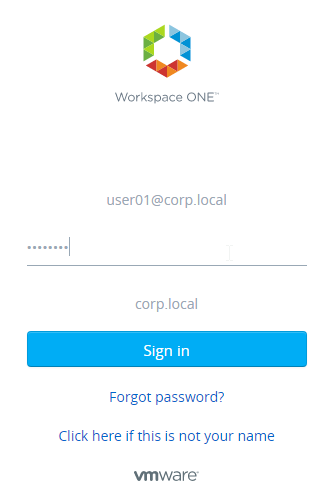
Administrators
- Sync the user that you want to assign the role to. Or sync the group that the user is a member of. If syncing a group, also sync the members of that group.

- You can assign a role from the Accounts > Users page by clicking a user and then clicking Edit Roles.
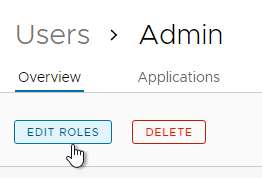
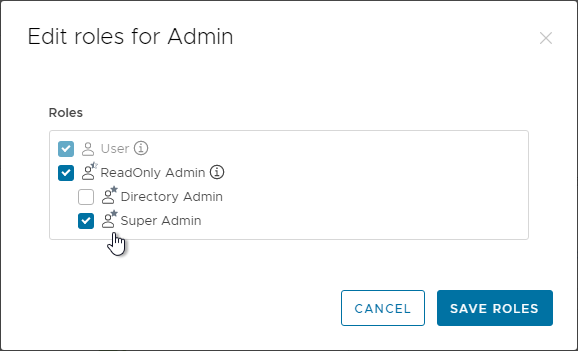
- To add a role, in VMware Access 22.09 and newer, go to Accounts > Roles.
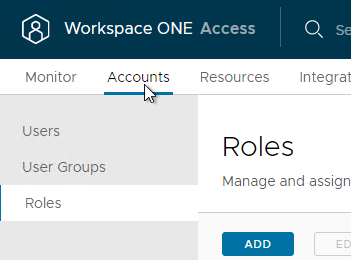
- In older VMware Access, go to the Roles tab.

- In older VMware Access, go to the Roles tab.
- You can add a Role. See VMware Blog Post Introducing Role-Based Access Control (RBAC) in VMware Identity Manager 3.2.
- Then you can assign synced users to a role (e.g., Super Admin) by selecting the role and then clicking Assign.
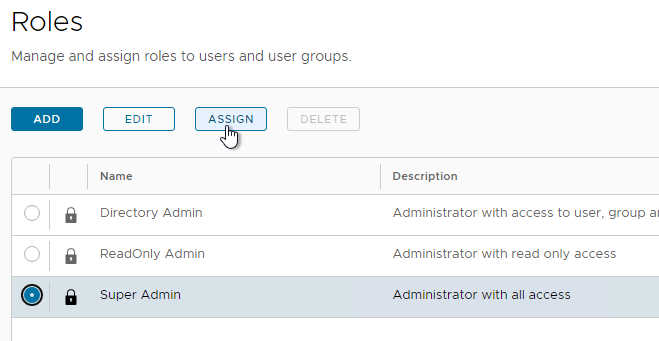
- Search for a synced user and then click Save.
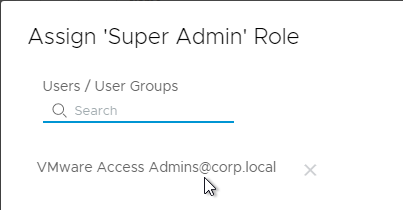
License
- In VMware Access 22.09 and newer, go to Settings > Appliance and then switch to the tab named License.
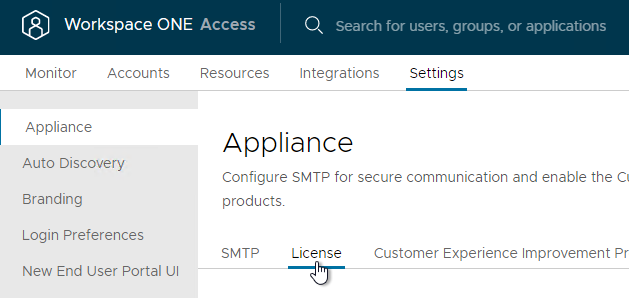
- Or in older VMware Access, switch to the tab named Appliance Settings.
- Switch to the sub-tab named License.
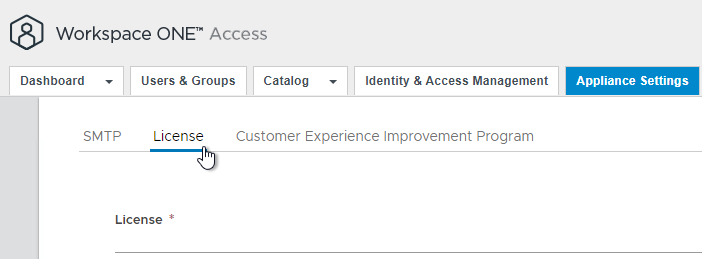
- Enter the license key and click Save. The Workspace ONE Access license is separate from your Horizon license.
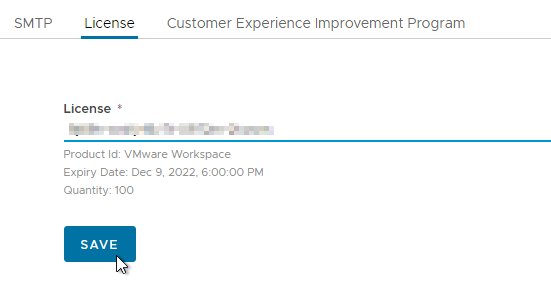
SMTP
- In VMware Access 22.09 and newer, go to Settings > Appliance and click the tab named SMTP.
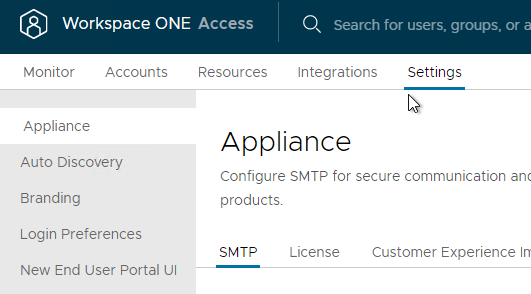
- In older VMware Access, on the top, click the Appliance Settings tab,
- Click the sub-tab named SMTP.
- Enter your mail server information and click Test Connection and then click Save.
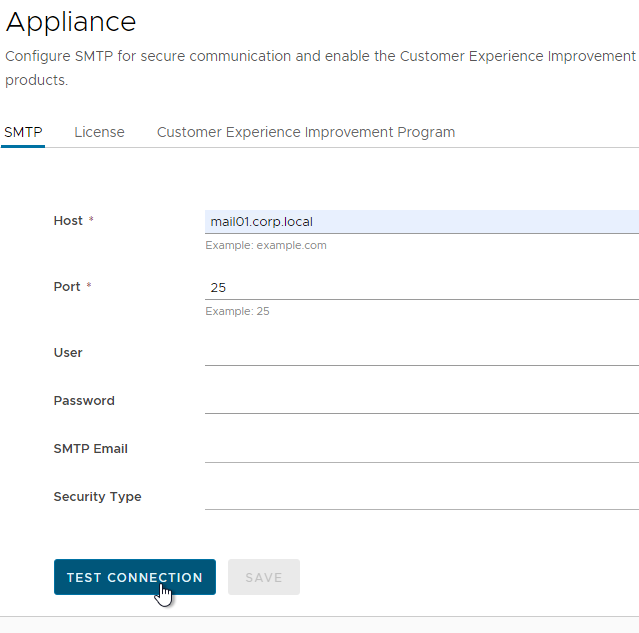
Kerberos Authentication
Kerberos lets users Single Sign-on to the VMware Access web page. Some notes on Kerberos authentication:
- It only works for Windows clients.
- The clients connect to the Connectors, so firewall must permit the inbound connection to the Connectors on TCP 443.
- For High Availability, load balance your Connectors.
- The Connector (or load balancer) must have a valid, trusted certificate.
- The Connector’s FQDN (or load balancer FQDN) must be in Internet Explorer’s Local Intranet zone.
Connector Certificate
To upload a certificate to the Connector:
- On the Windows Connector machine, run the Connector installer.
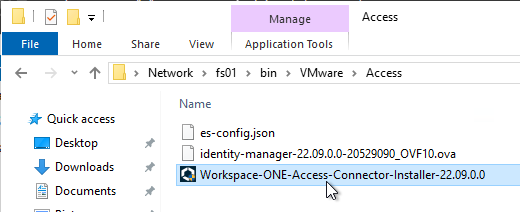
- In the Program Maintenance page, leave it set to Add/Remove Services and click Next.
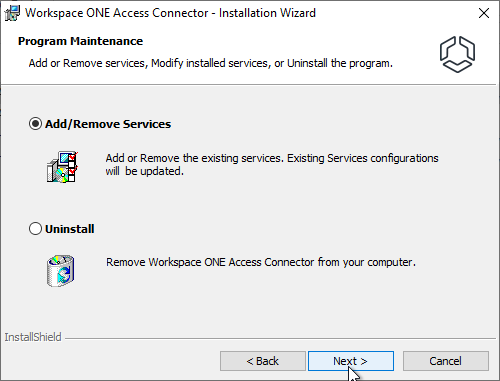
- Keep clicking Next until you get to the Install SSL Certificate for Kerberos Auth Service page. Browse to the .pfx, enter the password, and then finish the wizard.
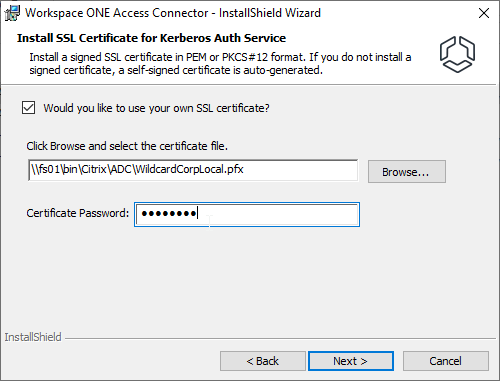
TCP 443 Inbound
TCP 443 must be opened inbound to the Connectors. You might have to add TCP 443 to a Windows Firewall rule.
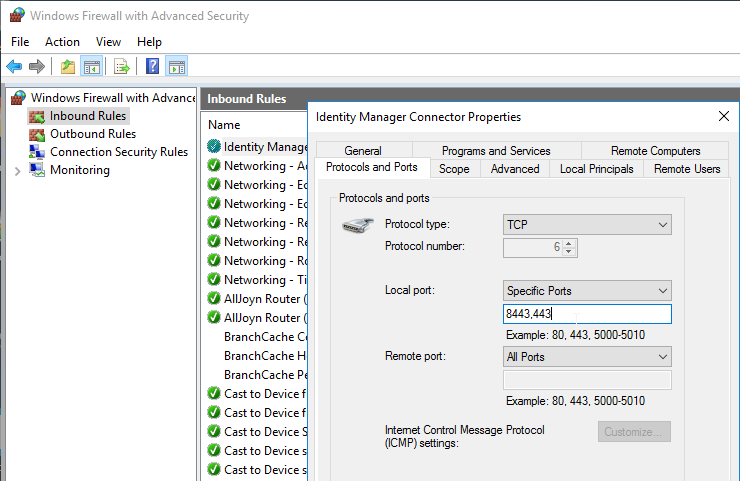
Enable Kerberos authentication
- In VMware Access 22.09 and newer, go to Integrations > Connector Authentication Methods. Click New and then click Kerberos.
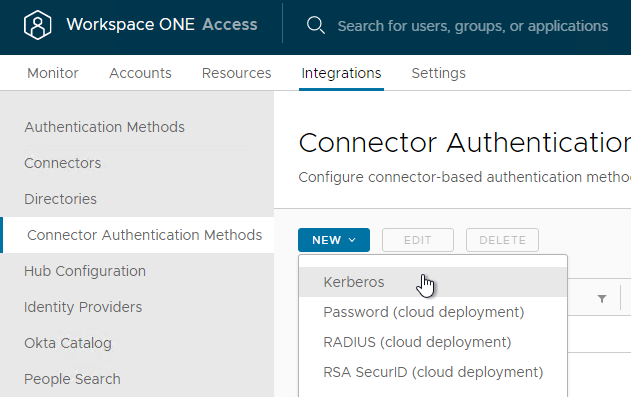
- On in older VMware Access, on the top, go to the Identity & Access Management tab.
- Click the sub-tab named Enterprise Authentication Methods.
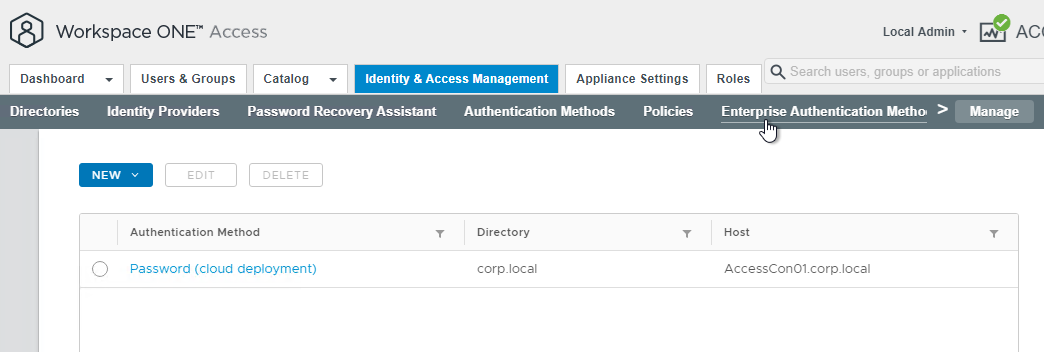
- Click the New button and then click Kerberos.
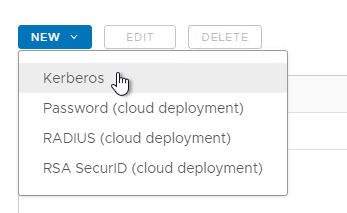
- In the Directory and Hosts page, select the Connectors. Then click Next.
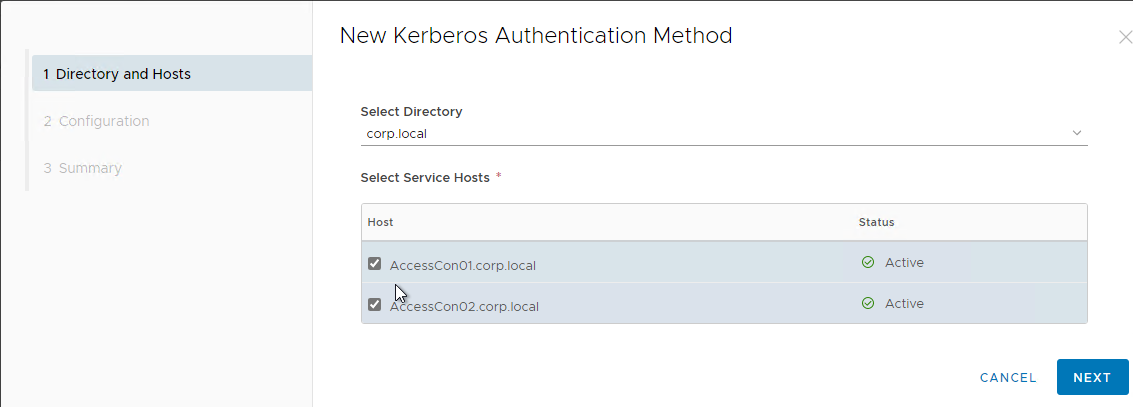
- In the Configuration page, if you plan to load balance the Connectors, then change Enable Redirect to Yes. Then finish the wizard.
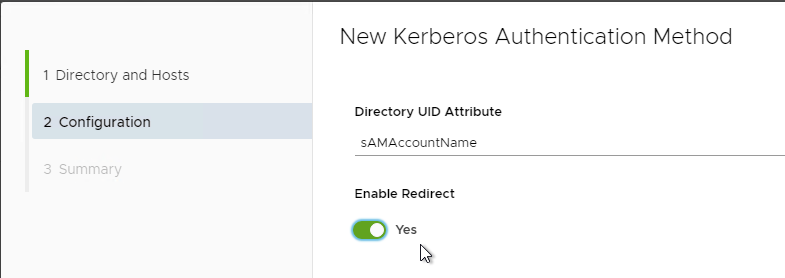
- In VMware Access 22.09 and newer, go to Integrations > Identity Providers.
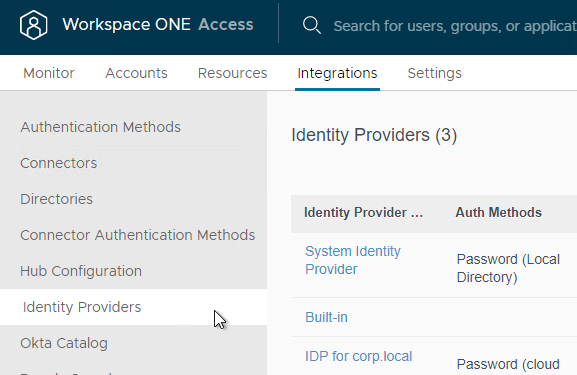
- Or in older VMware Access, go to Identity & Access Management > Identity Providers.
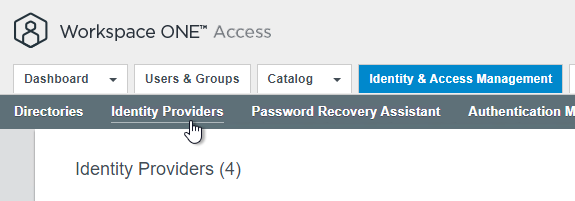
- Or in older VMware Access, go to Identity & Access Management > Identity Providers.
- On the top right, click Add Identity Provider and then click Create Workspace IDP.
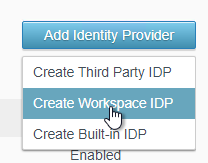
- Give the IDP a name.
- In the Users field, select the directory.
- In the Authentication Method field, select Kerberos.
- In the Network field, check the box next to ALL RANGES.
- In the IdP Hostname field, enter the FQDN that is load balanced to the Connectors. Click Add.
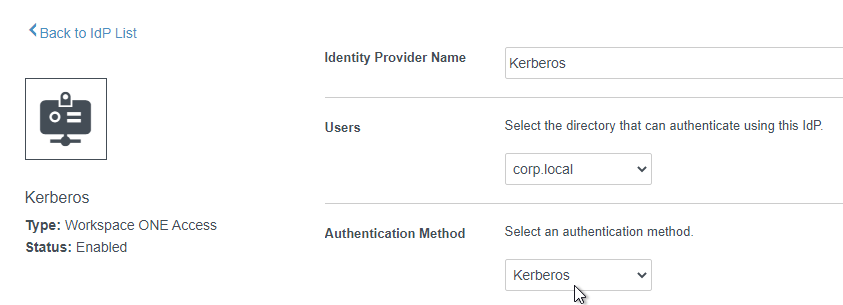
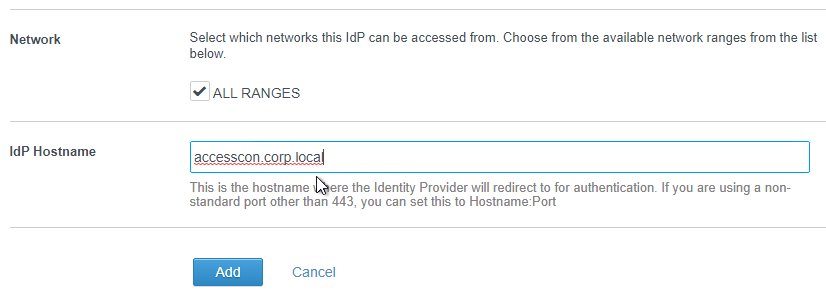
Configure Policy to use Kerberos
- In VMware Access 22.09 and newer, go to Resources > Policies and click the Network Ranges button.
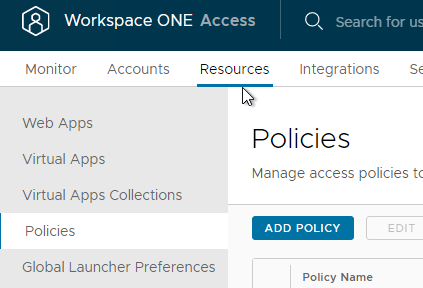
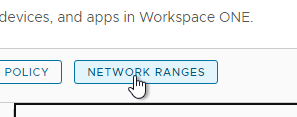
- Or in older VMware Access, go to Identity & Access Management > Manage > Policies and click Network Ranges.

- Or in older VMware Access, go to Identity & Access Management > Manage > Policies and click Network Ranges.
- Add a Network Range for internal networks if you haven’t already.
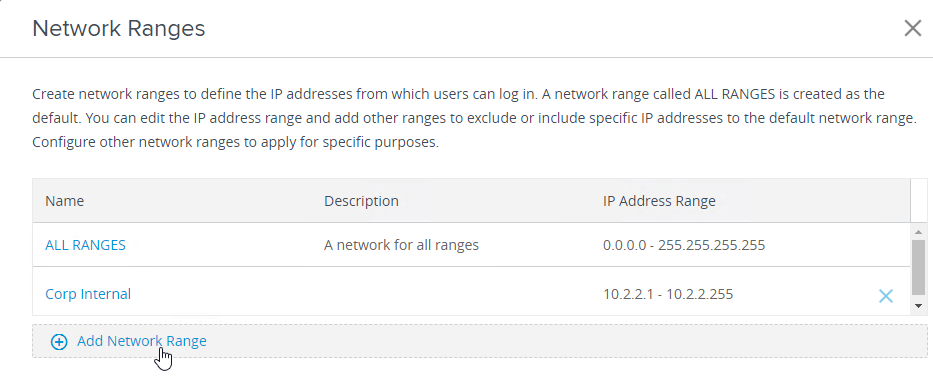
- At Resources > Policies, click Edit Default Policy.
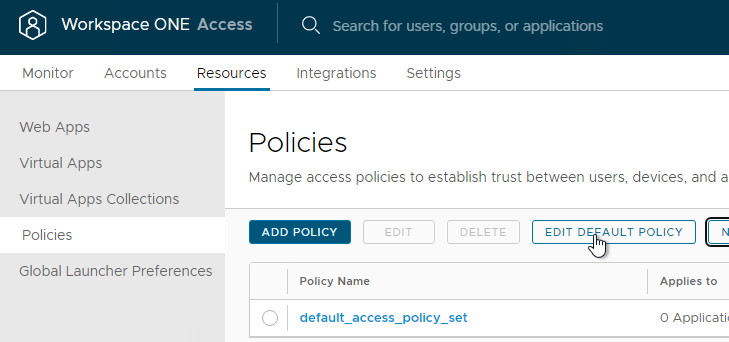
- Or in older VMware Access, go to Identity & Access Management > Manage > Policies.
- Click Edit Default Policy.

- Click Next to go to the Configuration page.
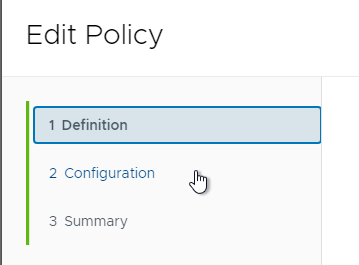
- Click Add Policy Rule. Or click the plus icon to add a Policy Rule.
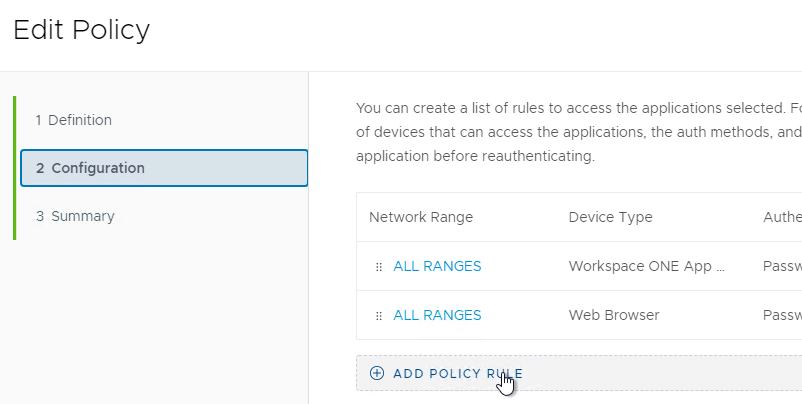
- Select a Network Range for the internal network.
- For and the user accessing content from, set it to Web Browser.
- Optionally configure and user belongs to group(s). When enabled, VMware Access asks the user for username only, and then looks up group membership to determine which authentication methods should be used. See Access Policy Settings at VMware Docs.
- Select Kerberos as the first authentication method.
- Select Password (cloud deployment) as the second authentication method. Click Save or OK.
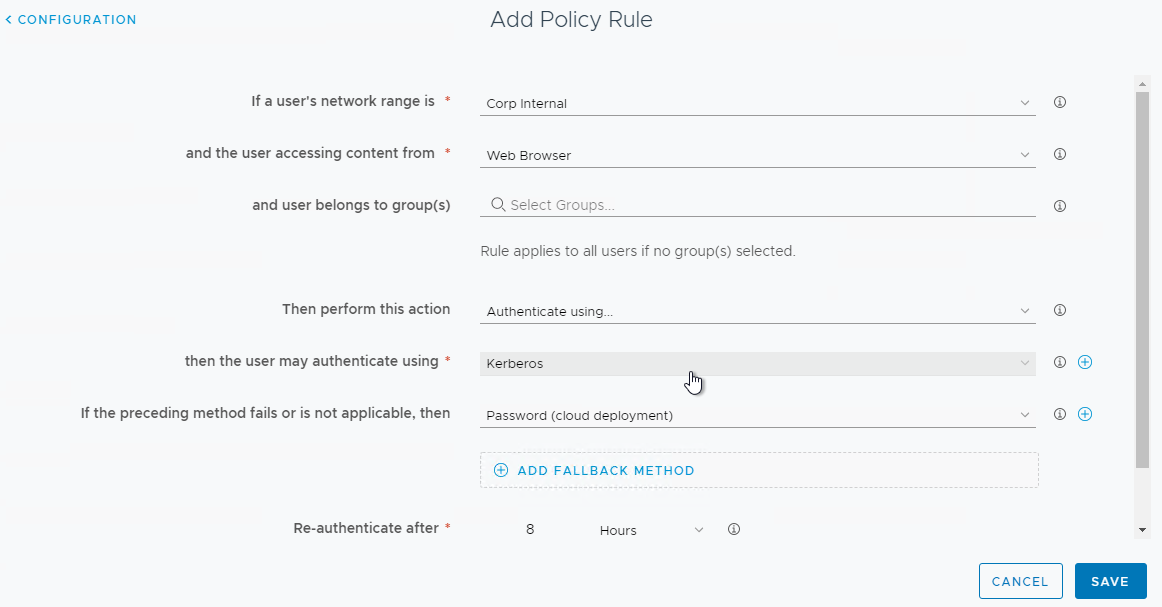
- Drag the new Policy Rule to move it to the top. Then click Next and Save.
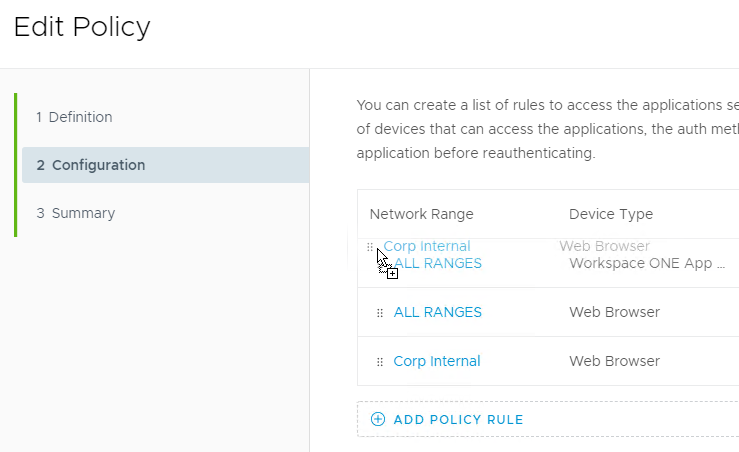
- If you break your config such that you can’t login anymore, then see Enabling Break-Glass URL Endpoint /SAAS/Login/0 in Workspace ONE Access at VMware Docs.
Customize Appearance
- You can change the browser’s title and favicon at Settings > Branding.
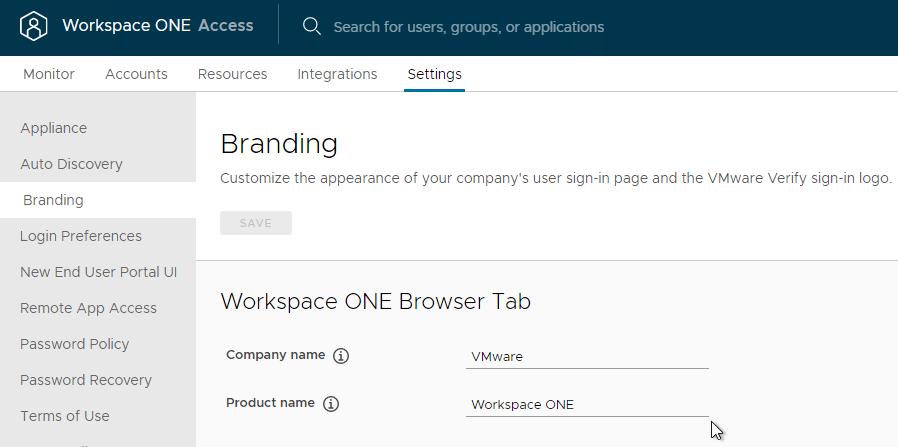
- Or in older VMware Access, go to Identity & Access Management > Setup > Custom Branding, on the Names & Logos tab.

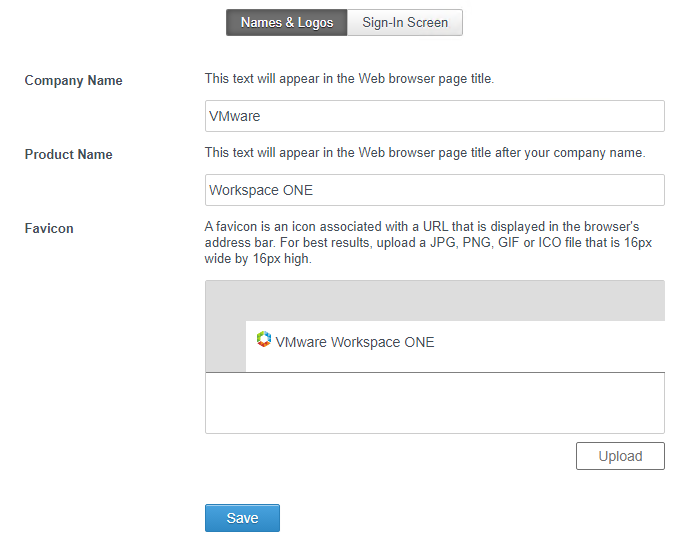
- Or in older VMware Access, go to Identity & Access Management > Setup > Custom Branding, on the Names & Logos tab.
- The Sign-In Screen section lets you upload a logo, upload an image, and change colors.
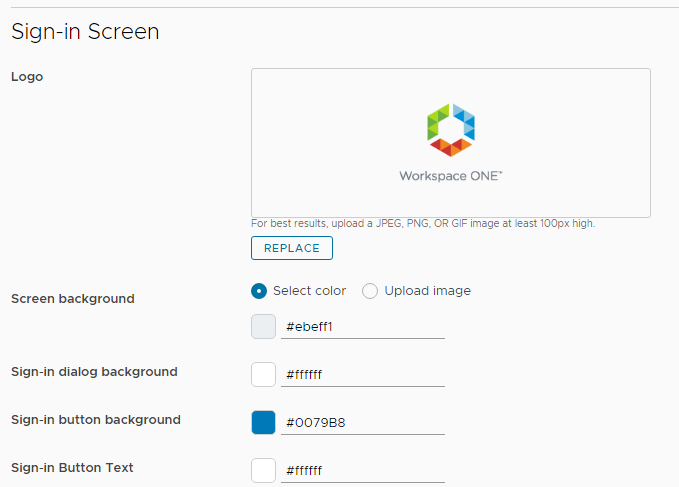
- If you go to Settings > Password Recovery, you can configure a link to a password recovery tool or change the Forgot Password message.
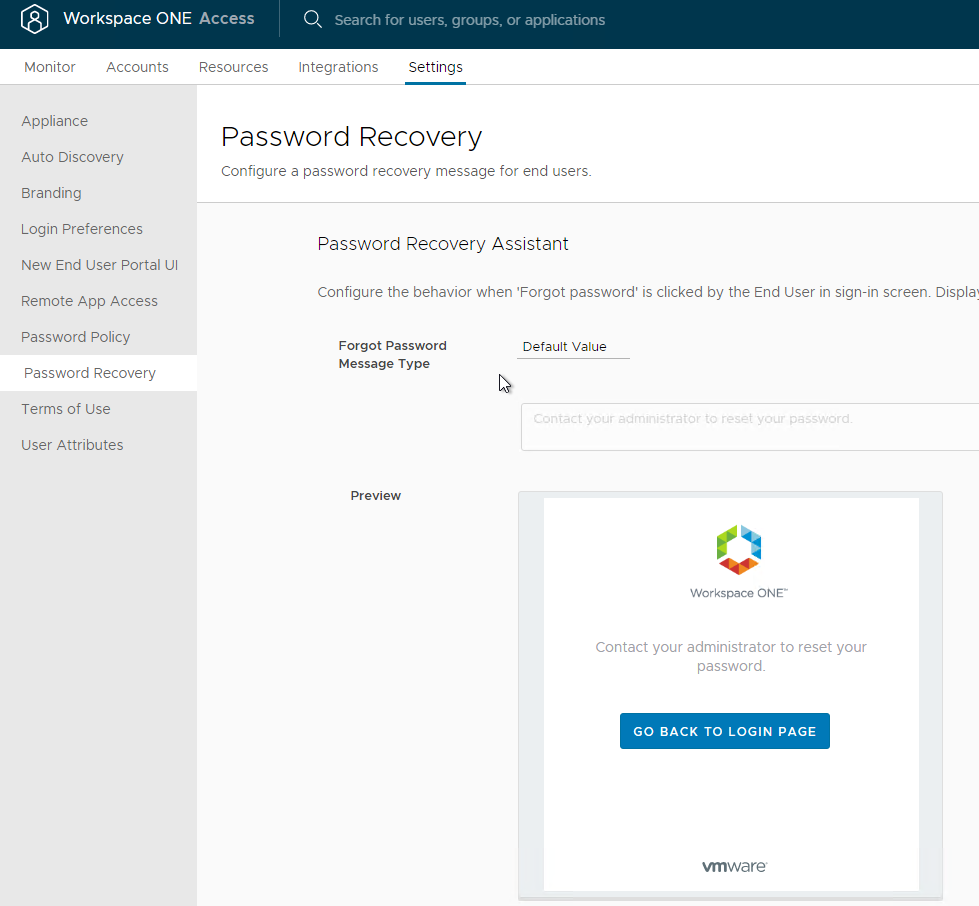
- In older VMware Access, find it at Identity & Access Management > Manage > Password Recovery Assistant.
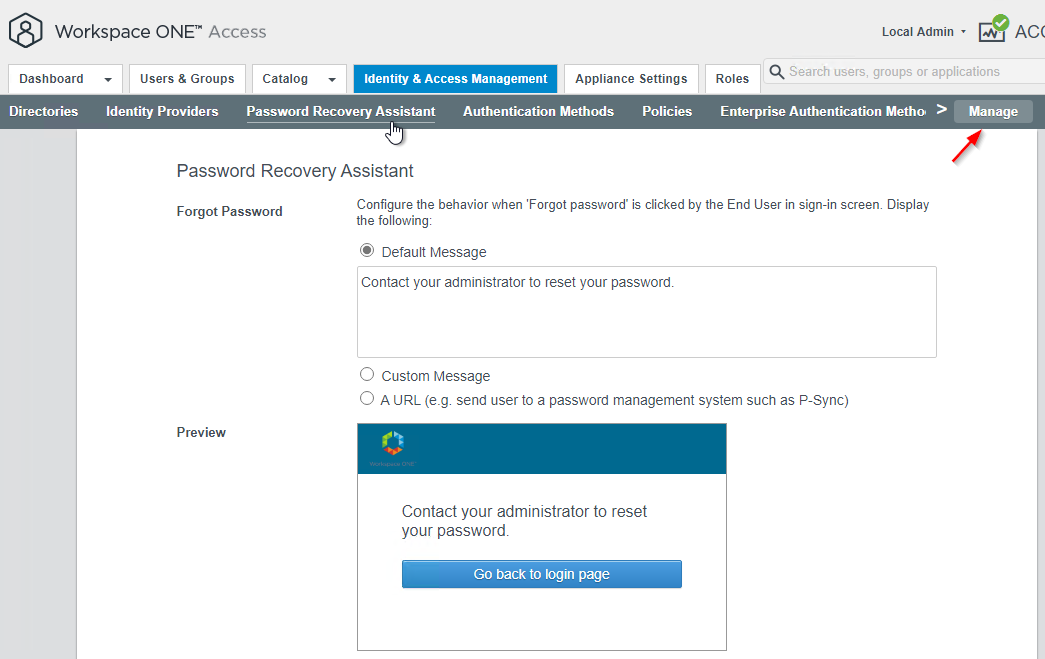
- In older VMware Access, find it at Identity & Access Management > Manage > Password Recovery Assistant.
- If you scroll down, you can optionally Show detailed message to End User when authentication fails.

- For branding of the user portal, go to Integrations > Hub Configuration and click Launch.
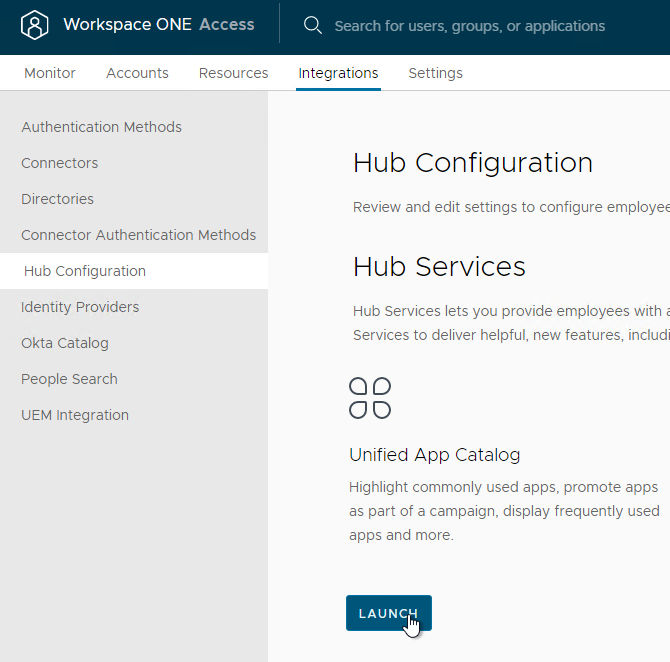
- Then go to the Branding page from inside Hub Services.
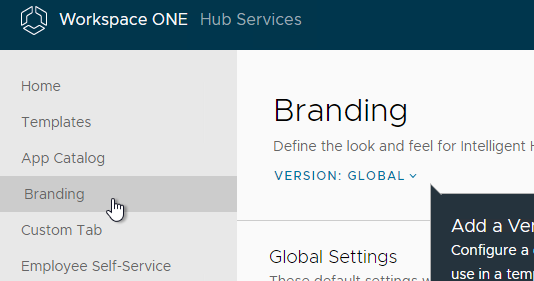
- Or in older VMware Access, click Catalog, and then click Settings.
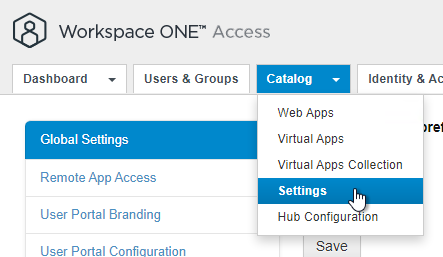
- On the left, click User Portal Branding.
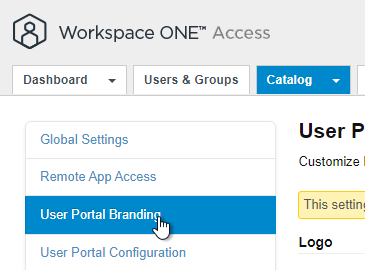
- Or in older VMware Access, click Catalog, and then click Settings.
- Make changes to Logos, colors, etc.
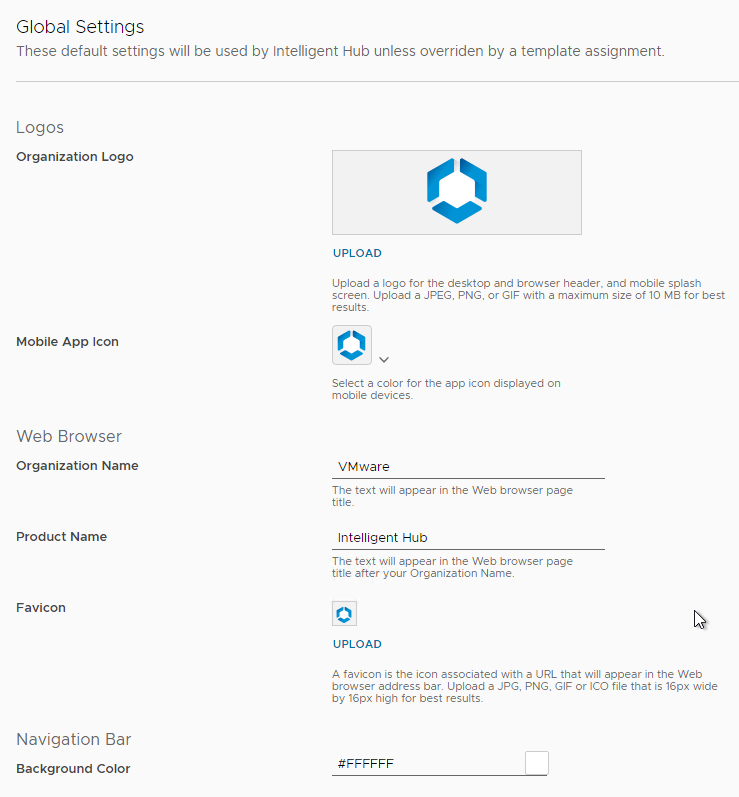
- On the top right, click Log out of Hub Services to return to the VMware Access administration console.

Resources
Horizon Console – Enable SAML Authentication
- Login to Horizon Console.
- On the left, under Settings, click Servers.
- On the right, switch to the Connection Servers tab.
- Select a Connection Server and click Edit.
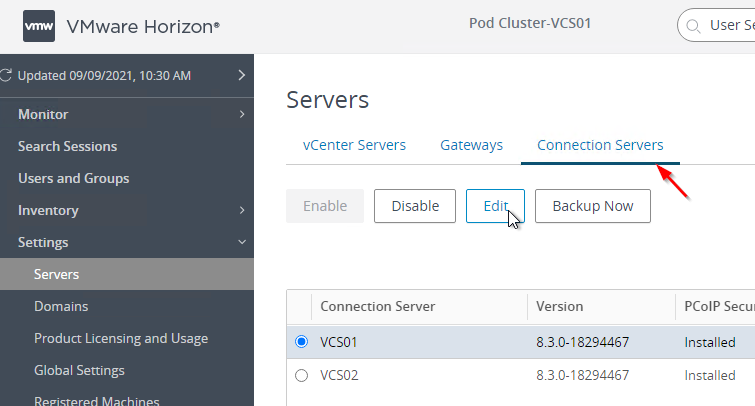
- On the Authentication tab, change Delegation of authentication to VMware Horizon to Allowed.
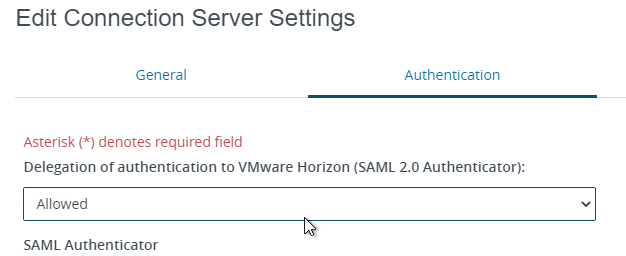
- Click Manage SAML Authenticators.
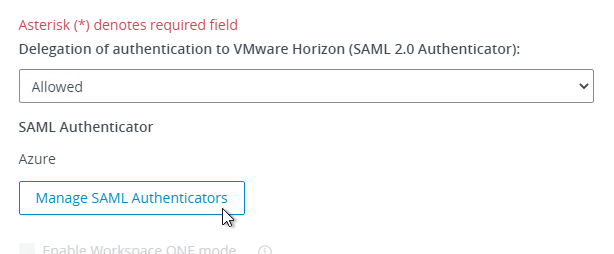
- Click Add.
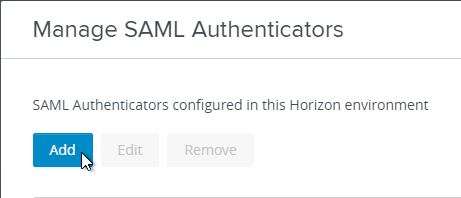
- In the Label field, enter a descriptive label.
- In the Metadata URL field, enter the VMware Access FQDN.
- In the Administration URL field, enter the VMware Access FQDN, and click OK.
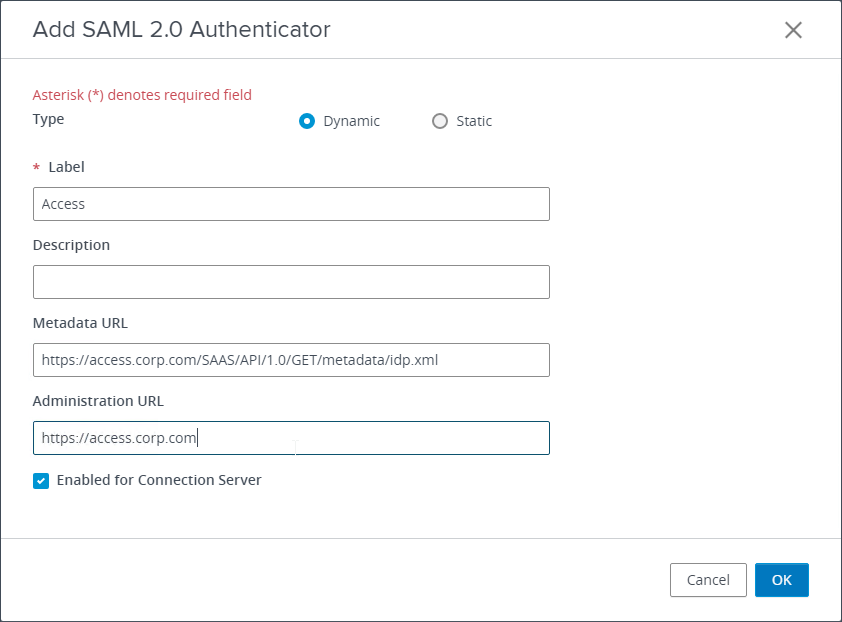
- If you see a certificate error, click View Certificate, and then click Accept.
- Click OK to close the Manage SAML Authenticators window.
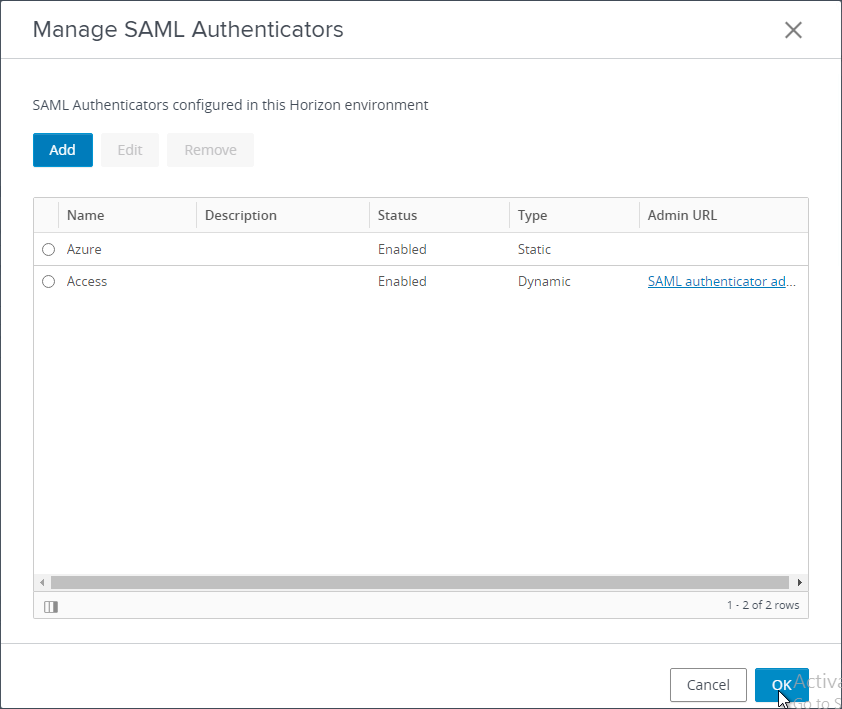
- There’s a Workspace ONE mode, which forces all Horizon Clients to connect through VMware Access instead of directly to the Connection Servers. Delegation of authentication must be set to Required before Workspace ONE mode can be enabled.
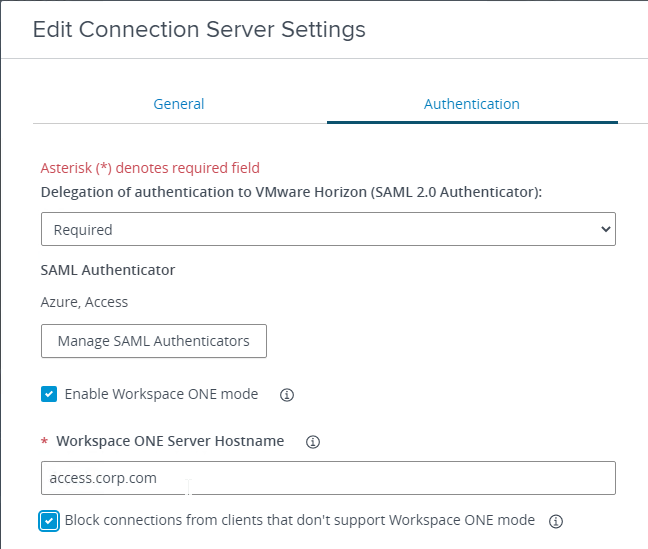
VMware Access – Virtual Apps Collection for Horizon
- In the VMware Access Admin Portal, go to Resources > Virtual Apps Collections.
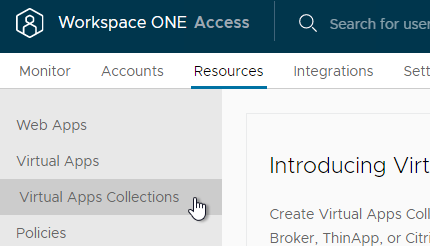
- Or in older VMware Access, in the VMware Access Admin Portal, click the Catalog tab, and then click Virtual Apps Collection.
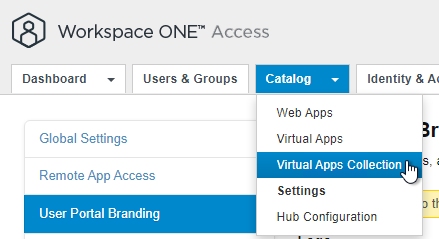
- Or in older VMware Access, in the VMware Access Admin Portal, click the Catalog tab, and then click Virtual Apps Collection.
- If you see Introducing Virtual Apps Collection page, click Get Started.
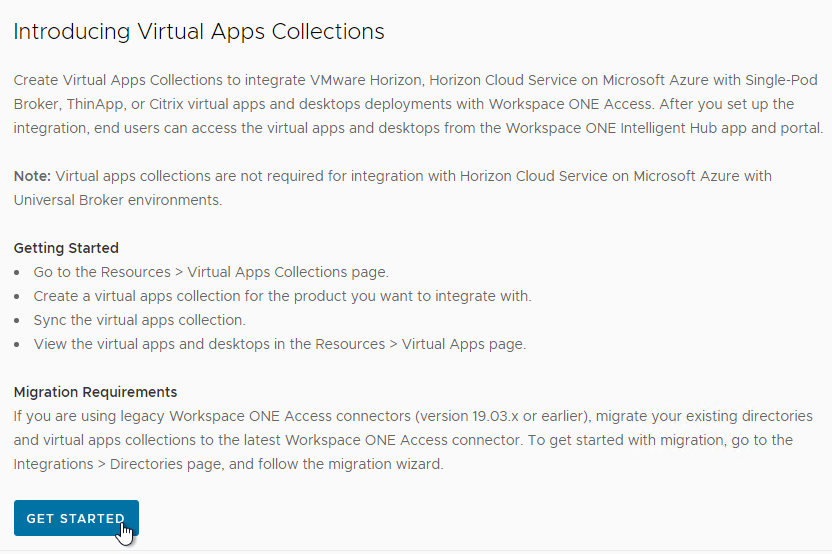
- Click the SELECT link in the Horizon box. Note: Horizon Cloud is only for Single Pod brokers. For Universal Broker, configure it from inside Horizon Cloud.
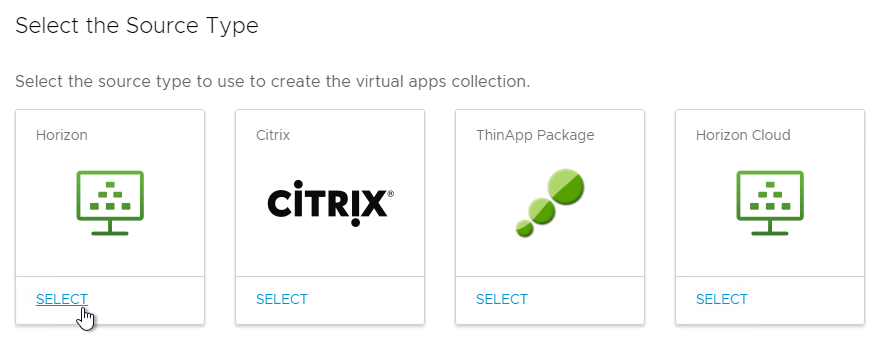
- Give the Horizon Connection a name.
- Arrange the Sync Connector appliances in priority order. Click Next.
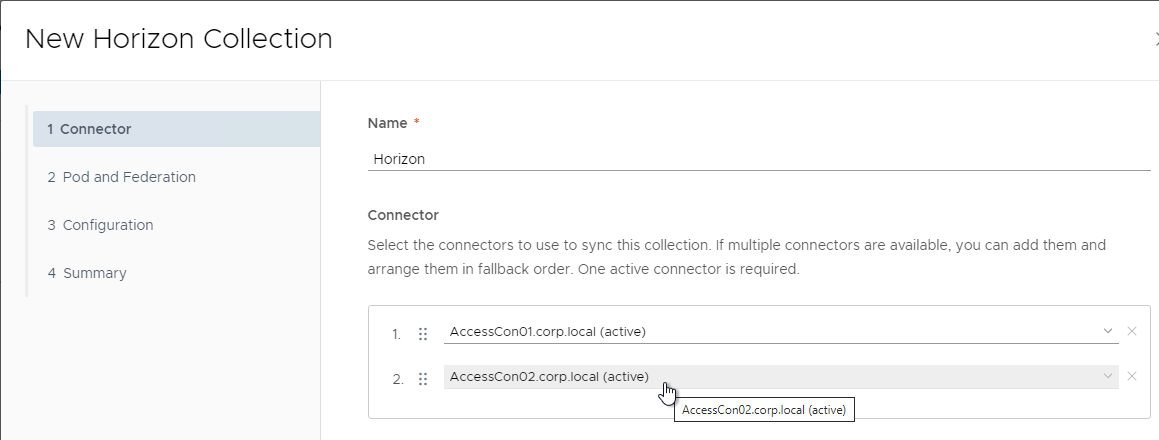
- Click Add a Pod.

- Enter the FQDN of a Connection Server in the Pod.
- Enter Horizon View admin credentials in UPN format. The account needs at least Read Only Administrator access to Horizon.
- There’s a True SSO option if you enabled a password-less authentication (e.g., SAML) to VMware Access.
- Click Add.
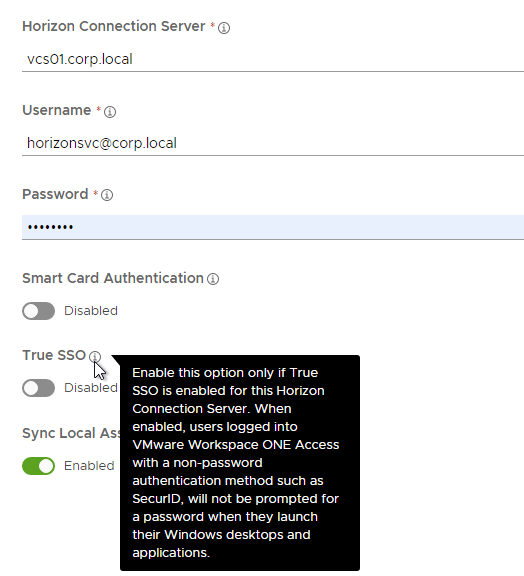
- You can optionally add more pods and then enable the Cloud Pod Architecture option. Click Next when done.
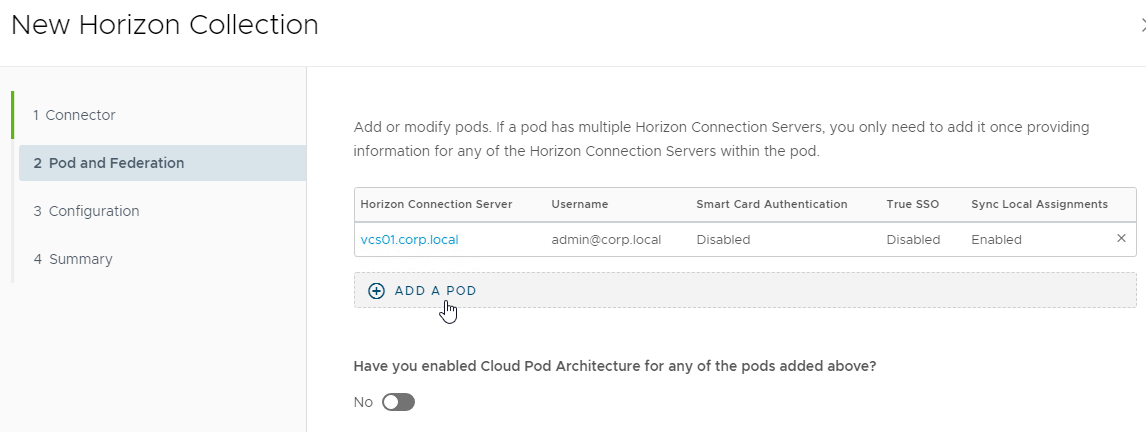
- Change the Sync Frequency and Safeguards as desired.
- Click Next when done.
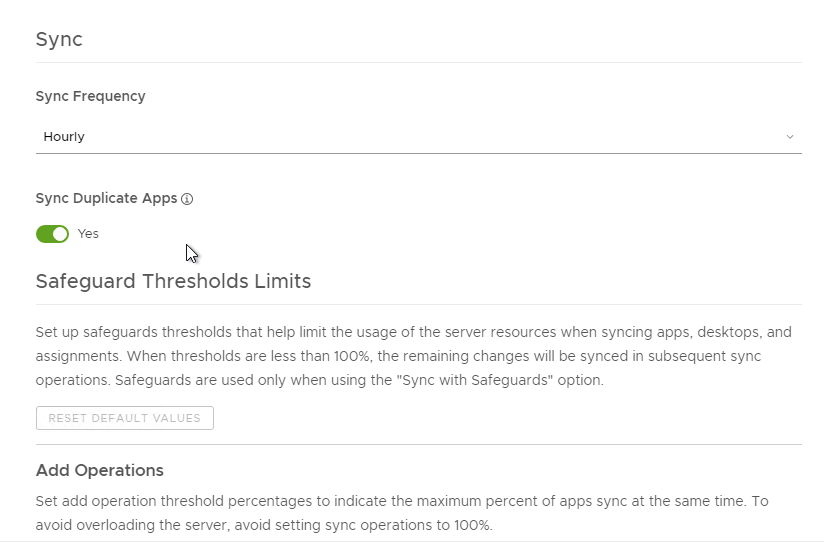
- Click Save & Configure. The connection is tested at this time.
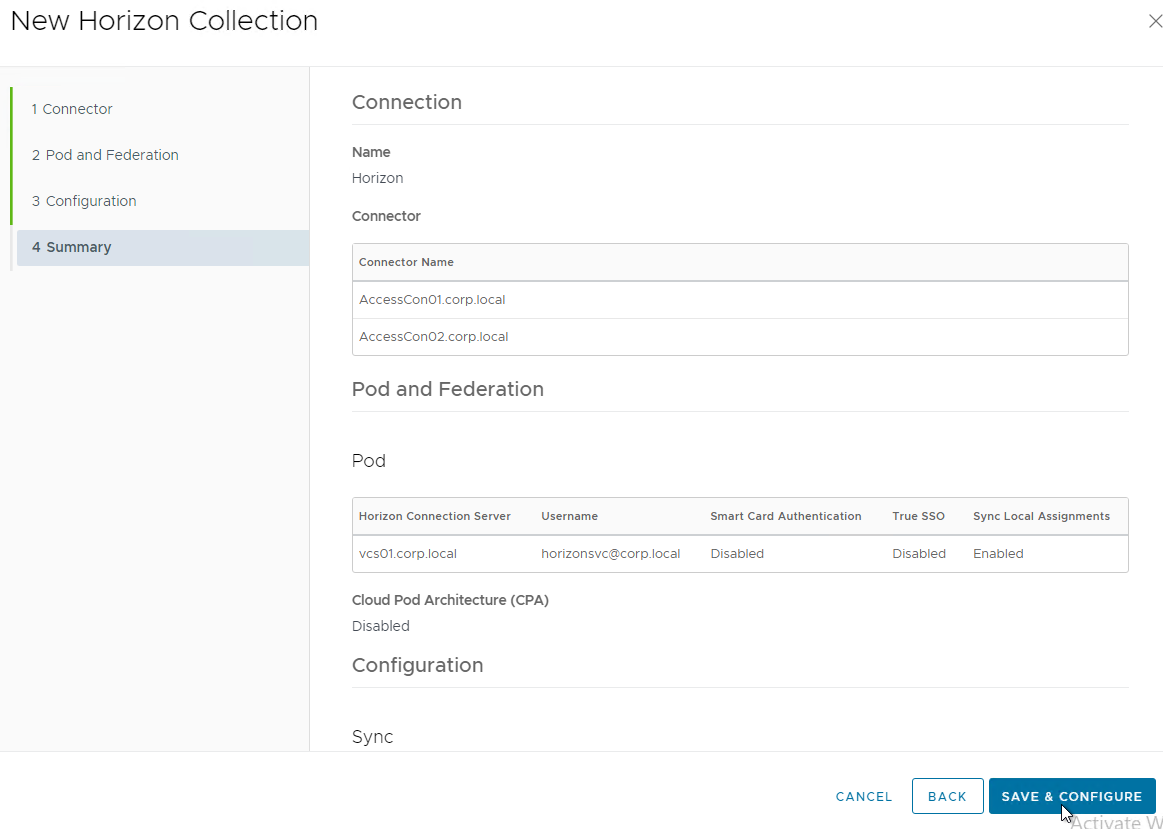
- The URLs for accessing Horizon are defined in each Network Range. For each Horizon URL, create Network Ranges. Or click All Ranges.
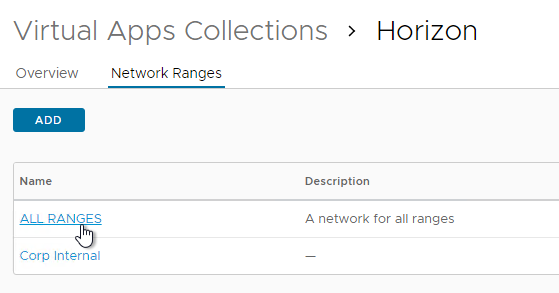
- Near the bottom, in the Client Access FQDN field, enter the FQDN that users in this Network Range use to login to Horizon. Then click Save. Note: the Horizon FQDN is different than the VMware Access FQDN.
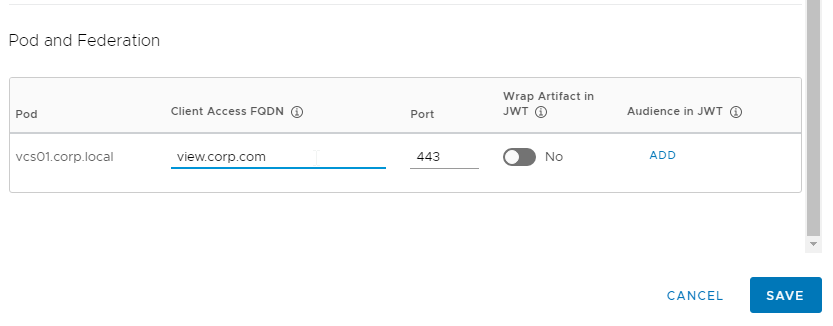
- After the Horizon Virtual Apps Collection is added, switch to the Overview tab, select the collection, and click Sync without safeguards.
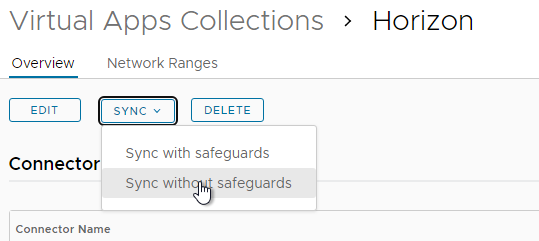
- Note: whenever you make a change to the pools in Horizon Administrator, you must either wait for the next automatic Sync time, or you can return to this screen and click Sync.
- You can click the alert icon to see issues.

- If you go to Resources > Virtual Apps, you will see your synced Application and Desktop pools
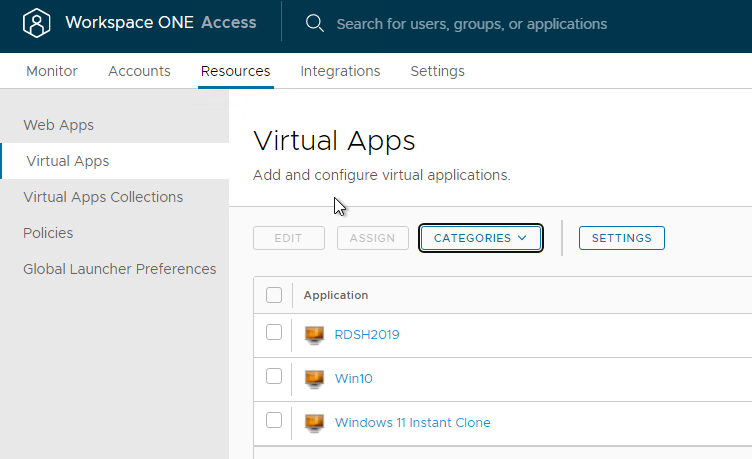
Horizon Pools Catalog
- In the VMware Access Admin console, at Resources > Virtual Apps, you can see the Horizon View icons. Only the pools in the root Access Group are synced.
- Click an icon, and then click View Assignments.
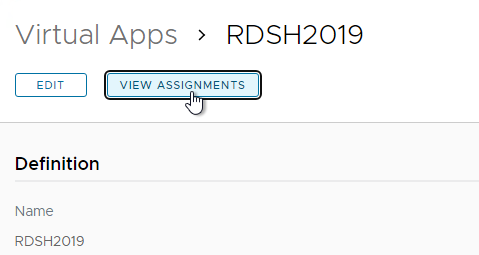
- Make sure entitlements are listed. Entitlements are assigned in Horizon Console, and not in VMware Access. VMware Access merely syncs the entitlements from Horizon.
- Only AD groups synced to VMware Access will be displayed. Domain Users are not synced by VMware Access and thus won’t be displayed here.
- If you make changes in Horizon Console, then manually sync the Virtual Apps Collection so the changes are reflected in VMware Access.

- Back in the Virtual Apps list, if you check the box next to one of the icons, you can place the icon in a Category by clicking the Categories menu.
- You can select or more existing categories.
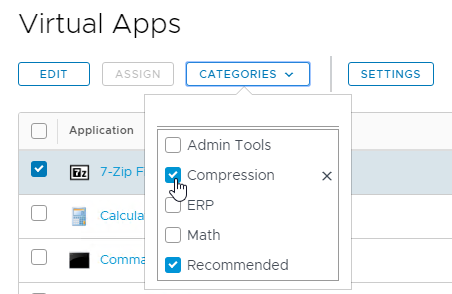
- Or type in a new category name at the top of the list.
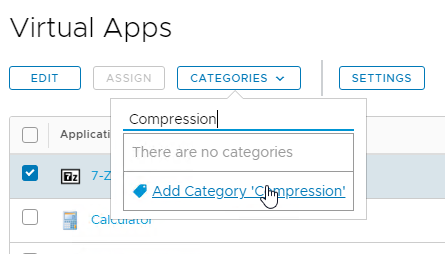 3The category is then displayed next to the catalog item.
3The category is then displayed next to the catalog item.

- You can select or more existing categories.
- There’s also a Recommended category.

- Recommended icons can be found in the User Portal at Apps > Recommended. Users can click the Categories drop-down to see other categories. Users have to logoff and log back in to see Category changes.
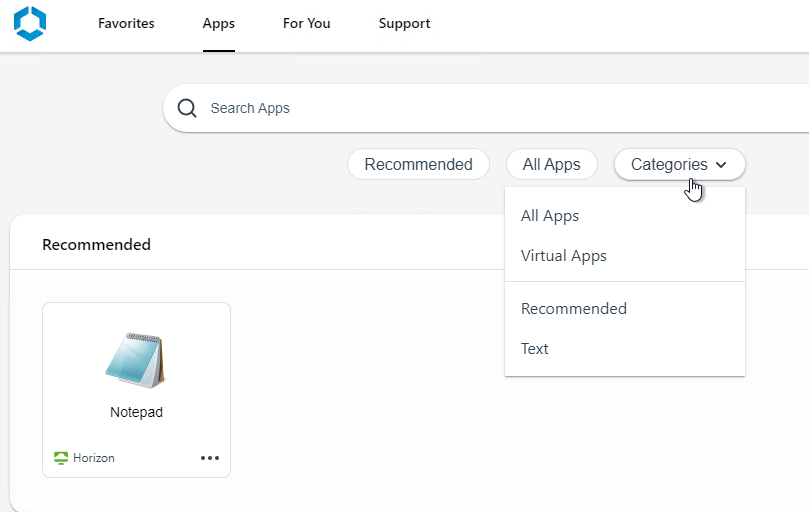
- Recommended icons can be found in the User Portal at Apps > Recommended. Users can click the Categories drop-down to see other categories. Users have to logoff and log back in to see Category changes.
- In VMware Access 22.09 and newer, user portal settings are configured in Hub Services. Launch it from Integrations > Hub Configuration.
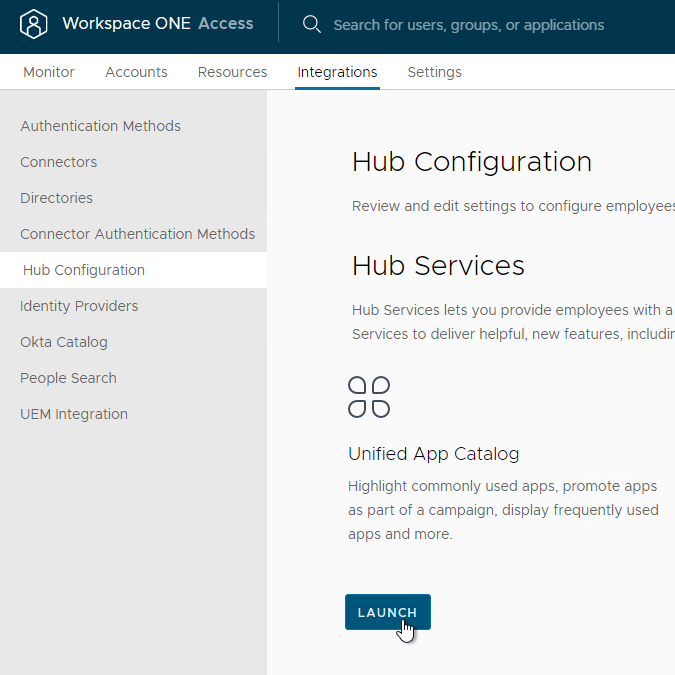
- The App Catalog page has some settings for the Catalog Layout.
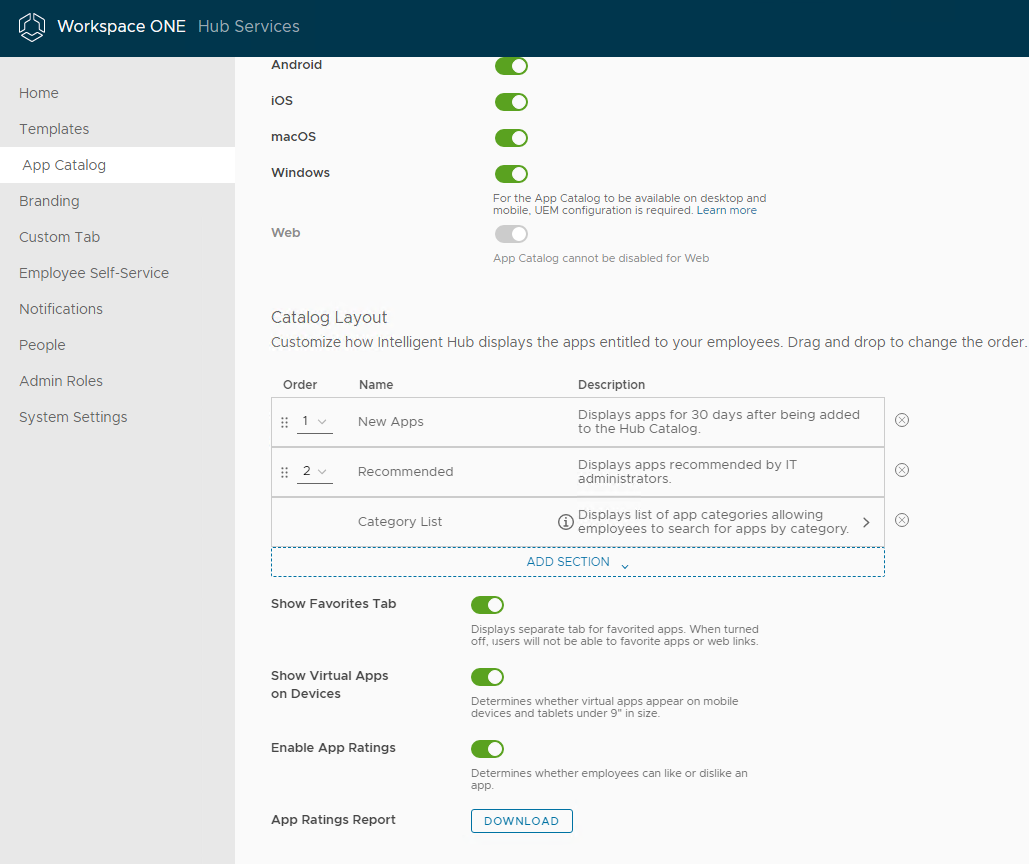
- Or in older VMware Access:
- Go to Catalog > Settings.
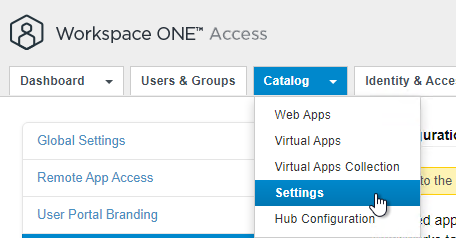
- On the left, click User Portal Configuration.
- From this screen, you can control tab visibility, and put recommended apps in the Bookmarks tab. Click Save when done.
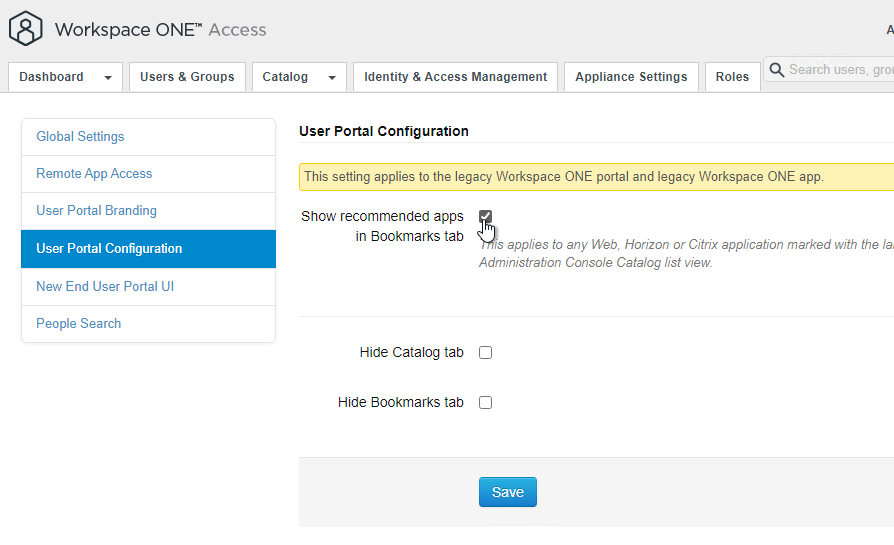
- Go to Catalog > Settings.
User Portal
The User Portal (aka Intelligent Hub) is the interface that non-administrators see after logging in. Administrators can switch to the User Portal by clicking the username on the top right and clicking User Portal.
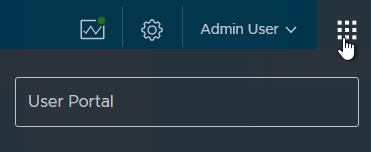
Administrators in the User Portal can switch to the Workspace ONE Access Console by clicking the username on the top right.
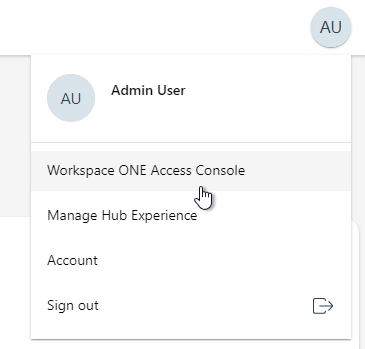
Some User Portal features:
- When a user logs in to the VMware Access web page the pool icons will be displayed.
- When the user clicks an icon, you can use either Horizon client or Browser for opening a pool.
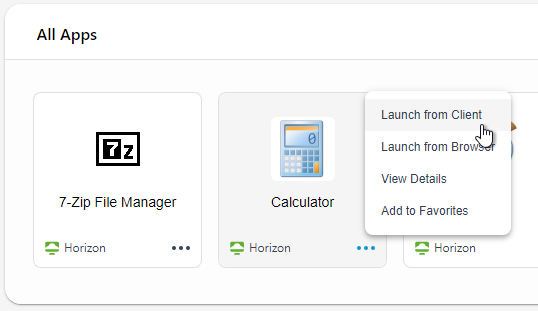
- To set the default launch method:
- On the top right, click your name, and click Account.
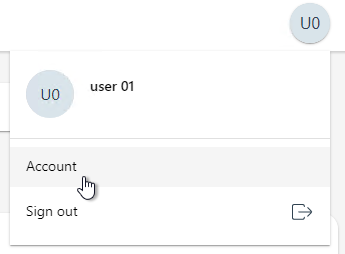
- In the Horizon Remote Apps section, click either Horizon Client or click Browser.
- The Horizon Client option has a link to download and Install the Horizon Client.
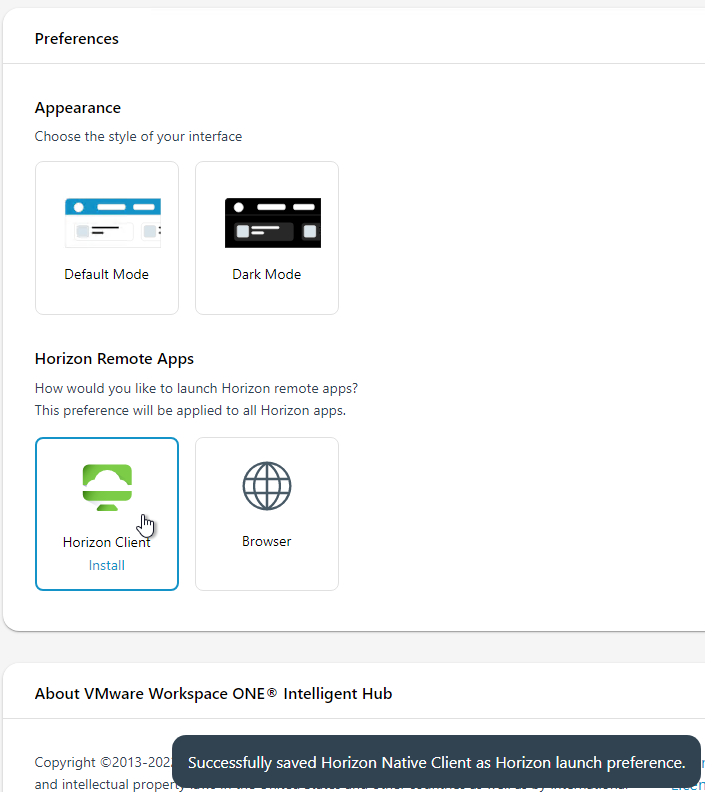
- On the top right, click your name, and click Account.
- Back in the Apps list, to mark an icon as a Favorite, click the three dots next to an icon and then click Add to Favorites.
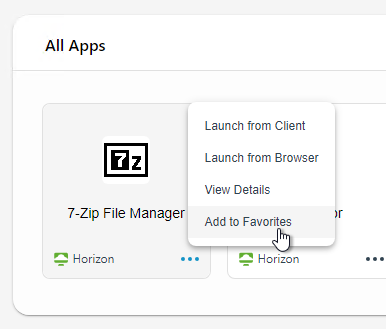
- Or open an app’s Details page, and then click the star icon.
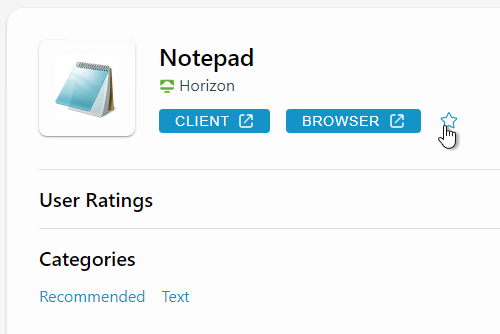
- Then you can click Favorites tab to display only icons that are marked as Favorites.
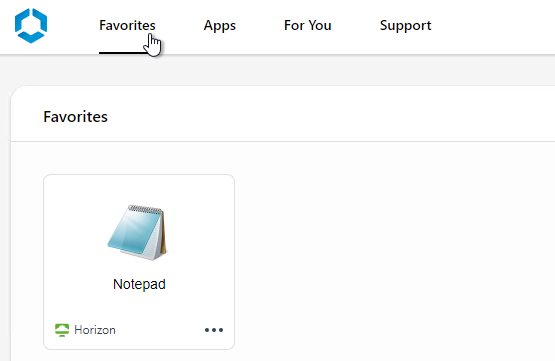
- If you configured Categories, they are listed in the Apps tab in the Categories drop-down.
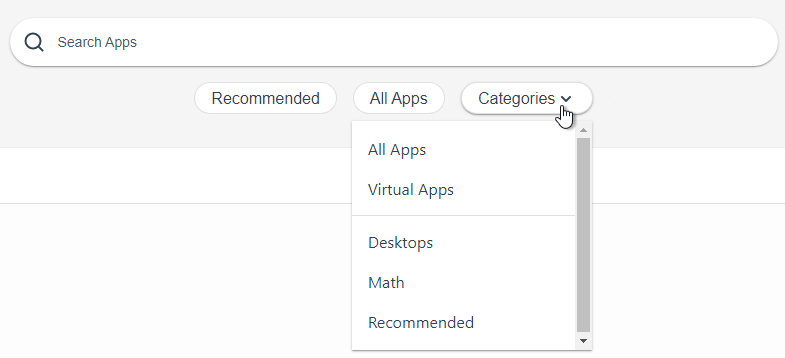
In my test Lab, i have deployed vIDM 19.0 with UAG. It’s working fine from internal network but not working from internet as connector node is not published over internet. Is there a way to achieve this configuration. (Although It’s working fine(internal and internet) when integrated with okta and okta is performing the authentication.)
Dear carl
I already read and do article that you post but I get error when try add directory over ldap/iwa
“connector communication failed with respons communication channel unavailablefor the connector.idmc.virtusindonesia.com”
maybe you have any suggestion ?
Dear carl
I already read and do article that you post but I get error when try add directory over ldap/iwa
“connector communication failed with respons communication channel unavailablefor the connector.idmc.virtusindonesia.com”
maybe you have any suggestion ?
Thanks for all of the great write-ups on Horizon products as they’ve helped tremendously! I did run across a problem maybe you have insight into with your Citrix background as well. Our Horizon VDI desktops have the Citrix Receiver installed which is using SSO for the storefront to access an EHR application. This has worked seamlessly up until we put Identity Manager using TrueSSO to access their desktops remotely. The Citrix Receiver is now unable to pass SSO and requests authentication to the backend server. If they do not go through TrueSSO and login directly to their workstation from a terminal or the Horizon Client they don’t have the issue. Any ideas on a way around this for the remote users?
Hello, I don’t understand why it would do that, however, I know that the TrueSSO certificate enrolls you onto the desktop using the users UPN and not the SAMAccountName. Could it be the Citrix Receiver is looking at the logon mechanism and seeing its not the conventional SAMAccountName logging the user on.
That’s what I’m thinking as well since the behavior is that the destination server is not receiving what’s expected and so it challenges the user
Lack of user’s password can be challenging. If you can configure Receiver to automatically login to StoreFront without needing the user’s password, then you can enable Citrix FAS on that StoreFront store to handle the SSON to the VDA.
Hi Carl,
Thank you for this. I am just installing 19.03 from fresh and manually copy/pasting my config from 3.3. I have 3 vIDM front ends load balanced by F5. Does this in turn mean i will need to build 3x Connectors and set different vIDM hostnames going to each vIDM appliance for it to be resilient or can i put the VIP hostname in that box (point 16 in your above doc) and just install 2 connectors?
In outbound mode, users don’t connect directly to the Connector, so there’s no need for load balancing of the Connectors. Two connectors might be sufficient for load and high availability. Also see https://techzone.vmware.com/resource/workspace-one-and-horizon-reference-architecture#component-design-vmware-identity-manager-architecture
I agree with @BC that this is confusing. If we have two connectors and put them on the same Workspace Provider, then what should we make the IDP hostname? Or should we make two different Workspace Providers and put one connector on each, and make the hostname the name of each connector?
Since the connectors are not accessed inbound (directly) by users, I’m guessing it doesn’t matter what you put there.
Thanks Carl! Would that also mean that it is unnecessary to add a certificate to the windows-based connector? With the other identity manager appliances I have put a SAN cert with the load balanced address and all the identity managers included on it. Since the connectors don’t have to be put in the Netscaler, it seems that putting a cert on it is only needed to avoid the warning when logging directly into it.
That seems correct to me.
Since cloning out the vIDM appliances (Node A Clone to Node B, then Node A Clone to Node C. Then powering them up one at a time with 10 mins in between, i have had persistent Elastic Search service issues. I just cant seem to get the service started.
I had to reboot them to get it to work. It didn’t work on first boot.
Any particular order? I’ve tried sequential one at a time, all at the same time, and Node A leave for 10 mins then Nodes B&C together.
Might be a call to Support Monday morning. 🙁
Hey BC,
I have 3 nodes and had the exact same issue you did. I rebooted the master node, waited for the blue screen to come up. Then I rebooted node 2, waited for it to come up. Then the elastisearch showed green.
I don’t get it, but that’s what worked.
Hi BC, I am just installing 19.03 vidm and get error
“connector communication failed with respons communication channel unavailablefor the connector.idmc.virtusindonesia.com”
did you ever get error like that ?
Hi, I’ve the same issue with windows based connectors. The connectors are enabled in vIDM but when I try to add the AD, the time out message appears.
I can browse from connectors the LB FQDN without problem. Could you help me?
Hi,
After updating the SSL certificate in our Identity Manager Tenant,
i’m unable to login with the “admin” local user.
if i try to login with this url :
“https:///SAAS/login/0”
login is ok, but unable to setup the platform.
no access on settings .
Any idea ?
you mean want to put certificate to your vidm ?
If you have this problem then your certificate does not match the IDM FQDN.
When I try to access virtual app from Identity, It try to open in native app, but a error message is showed.
“Horizon Server expects to obtain its login credentials from another application..”
What should I config to can access virtual apps in native app (horizon) from Identity without problems?
Hi
I am using and Horizon
In Horizon cliente all apps work fine
In WorkSpace ONE (App) any app work fine, when I try to access, an error happend: “Error starting the resource”.
In identity console I can see the error: LAUNCH error (ViewApp)
The problem seems to be to open via browser
Any Idea how to fix it?
Thanks
Dear Carl.
when integrating IDM with Horizon Desktop. can we add the uag fqdn instead adding connection server fqdn?
i am trying this but its not working in my lab.i am getting “could no connect to URL” when adding the UAG to IDM
What Proxy Pattern do you have configured for UAG Reverse Proxy to IDM? https://docs.vmware.com/en/Unified-Access-Gateway/3.3.1/com.vmware.uag-331-deploy-config.doc/GUID-A132FA27-8BF1-4ED9-BCDB-1E40078A2F86.html ?
Or are you saying that when you configure Reverse Proxy on the UAG that UAG cannot communicate with IDM? If so, there could be a problem with the certificate thumbprint that you entered.
Hi Carl,
I have issue in integrating windows based IDM connector to tenant based Identity Manager, whereas with Linux based OVA connector I do not have any issues it works fine, but not with windows based connector, error message is “connection refused”.
Machine where windows connector installed is running on proxy settings with all ports opened, on the same machine Iam able to browse my tenant identity manager without any issues.
Any suggestion on this.
Hi,
Same Issue Here. Did you resolve your issue ?
HI Carl
i have problem to Add Directory like in CONFIGURATION – ACTIVE DIRECTORY point 13.
I always get error mesage : FAILED TO QUERY FOR DOMAINS
I have set DNS ( checked trough SSH etc/resolv.conf)
i can connect identity manager to Active directory in setup ( already connected sucessfuly)
Whats your oppinion? thanks
Hello Carl,
Love your blog, I hope you respond to this question soon…
I installed the IDM 3.3 appliance on-premise. found the License is missing. I tried to add the License, but it displays “License could not be saved”. It kinda implies that there’s a modify permission issue with IDM even though I’m logged is as “admin”…any ideas?
By the way, I also experienced the same thing when trying to configure the integration with IDM to UEM 1810 on-premise…”could not save” or similar error message…
This looks like the same issue that occurred for other users on this blog, but haven’t seen a reply from you yet.
Thanks!
Hi, I have TrueSSO implemented, but when testing it is working as required when testing internally. From external, it is not prompting, but the VDI session is asking for credentials. What am I missing to check. I have enabled the TrueSSO option in vIDM.
Have you tried the True SSO Diagnostic Utility? https://labs.vmware.com/flings/true-sso-diagnostic-utility
I’m curious, would TrueSSO work on non-domain joined workstations? Just create a user certificate and install it on the client machine. One thing Horizon is missing is the ability to save password in a Windows environment where they aren’t joined to the same domain or are in a workgroup.
Hello Carl, I am upgrade IDM from 3.2 to 3.3. found the License is missing. I try to re-add the License, but it show “License could not be saved”.
The license show valid
“Product ID: VMware Workspace
Expiry Date: Permanent
Quantity: 100”
But Cannot saved.
Try New Install, same problems. Please help!!!!
I am seeing the same problem. Any ideas?
Having the same problem, don’t see a response from Carl yet.
Has anyone figured this out yet?
So turns out that this is a known User Interface (UI) issue on the vidm 3.3 version. You can confirm the license key in “GlobalConfigParameters” section on the vidm SQL database. VMware engineering team is already aware of this issue and they asked me to ignore this error message and should be fixed in upcoming releases.
Not much help but should explain why we all see this.
GlobalConfigParameters has a series of ids. Which one do we have to look for to confirm this?
Hello! Thank you!
Could you please help me?
I had this error..
“You are no entitled to use the system”
But, directly access on the Horizon Client or the Web Client is works. Through Identity Manager ocours this error.
Thank you buddy!
I am having this problem as well. I noticed that if I entitle the user directly in the connection server it works. But if I use a group it doesn’t.
Carl
First off- Thanks for all of your great articles!! I’ve found them very helpful in my journeys
I’ve manged to get Identity manger configured and working. However, I have a strange issue. When I try to login from outside of the network (DMZ) the Work space one login page looks funny (Missing background, mostly plain test with the company logo) However, after I login one time this is no longer the issue and the web page loads correctly. It will stay this way until the browser cache, cookies, etc. are cleared. Then back to the strange login page until first login.
We are using a UAG connected to a Horizon Connection server and the reverse proky has been set to Identity manger.
Have you seen this behavior before? It happens in all web browsers.
Sounds like you have an issue with the UAG proxy pattern for vIDM. Did you check it?
Thanks for the reply Richard. I’ve got the “Proxy Pattern” set to (/|/SAAS(.*)|/hc(.*)|/web(.*)|/catalog-portal(.*)) in the reverse proxy setting for vIDM.
The proxy patter for the Horizon connection settings is (/view-client(.*)|/portal(.*)|/appblast(.*))
the “/” was removed from the Connection server proxy to the user is always directed to vIDM.
I forgot to mention. I fixed the issues with logging in. Only issue is the web page loading incorrectly until first log in. after first login it loads fine every time after. Unless the browser cache is cleared.
Hi Carl,
We have IDM set up in our DMZ along with UAGs. Externally the URL supplied by IDM sends connections to our load balanced UAGs. When our users authenticate to IDM and click the icon to start the Horizon desktop we find that the user is prompted a second time for user credentials by the Horizon client itself.
So although I have authenticated into IDM this authentication does not seem to pass through to the connection that is initiated through the Blast gateway after clicking the IDM icon.
We have no problems connecting directly internally, only when trying to connect via UAGs. What have I missed here? Does Workspace ONE mode have to be enabled to get this functionality (it is switched off at present) or is there something else I have missed that needs to be configured e.g. TrueSSO, Kerberos?
What is the IdP for IDM? Is it a separate SAML IdP, like ADFS? If so, then you need True SSO.
I assume SAML is configured between IDM and the Connection Servers.
hi Carl, I am trying to have SAML integration between IDM and Airwatch – and IDM and Oracle. Appreciate if there is configuration guide for this.
Thanks
Like this? https://docs.vmware.com/en/VMware-Identity-Manager/3.3/idm-administrator/GUID-0C459D5A-A0FF-4893-87A0-10ADDC4E1B8D.html and https://resources.workspaceone.com/view/j87fqmyx6bjzwbvjvvtq/en
Can someone clarify how Identity Manager in combination with AirWatch supports multi tenacy?
I have linked our AirWatch environment with Identity Manager. I let users synchronize with AirWatch in Identity Manager. In the Identity manager I have not configured an AD connection; what is not necessary. (Right?)
((I can also log in with Active Directory users and authentication to Active Directory through AirWatch.)) So this works well in the test setup.
Our organization consists of several internal divisions. What are separate ‘Customer’ groups with us in AirWatch. Each division also has its own AD, and another domain.
We make full use of the multi tenacy possibilities of AirWatch. (multiple AD connectors, APNS, etc.)
Question is. In what way is Identity Manager multi tenacy? For example, I can only configure settings for identity authentication methods at ‘global’ level in Identity Manager. For example the ‘Password (AirWatch Connector)’. Because I have several ‘Customer’ groups, I would also have to be able to set different configurations here. What are the possibilities for setting this up?
I find out that I think that many parameters can only be setup at ‘global’. Do I need to install Identity Manager multiple times? And is this possible on the same server?
Thanks in advance!
Hello Carl, I am running into an issue with my RDSH applications. Some of our applications are wrapped via a CMD. In Horizon the app icon shows as CMD instead of the app itself. Using powershell we are able to re-associate the app icon with the app instead of the CMD icon and I am told this should pass through to vIDM but this is not occuring. Any thoughts on this?
Hi Carl,
I have VIDM and Horizon deployed and in working condition. Published app is only Desktop pool. I want to publish RDSH apps in vIDM without horiozn. Is it possible to do so? if yes then please do let me know how.
I want access to VIDM from the external network via UAG and reverse proxy configuration.
In UAG I have the following configuration:
Instance ID: VIDM
Proxy destination URL: https://vidm-01.domain.com (local Identity manager address)
Thumbprint: SSL certificate thumbprint
Proxy Pattern: (/|/SAAS(.*)|/SAAS/auth/wsfed/active/logon|/hc(.*)|/web(.*)|/catalog-portal(.*))
The external address that points to UAG is https://idm.domain.com
When I go to https://idm.domain.com, a Workspace portal opens.
I have the problem, when user login, UAG redirect me to internal Identity manager url: https://vidm-01.domain.com. The login for System domain works corretly, problem is only for users with Windows domain.
What needs to be set up to make the user login from external network?
your VIDM workspace url needs to match what the user is connecting to. as your external url is “idm.domain.com” then you need to configure vidm to respond with the same url by going to https://vidm-01.domain.com:8443/cfg/workspaceUrl and setting it to “https://idm.domain.com” and then update the UAG to point to “https://idm.domain.com”.
Thanks Carl. By any chance you have the instruction for integrating IDM 3.2 with Horizon DaaS?
Hi Carl,
I am new to Horizon IDM and I have a question; How would I disable external (internet) network admin login access? (local directory)
I have tried a few variations with creating Access Policies, that eventually locked me out and I had to re-deploy the OVA and reconfigure. Forgive my ignorance, as I stated, new to this device. Thank you for any assistance.
HI Carl,
Thanks for the helpful details on IDM, Could you please give a guidance on true SSO configuration on IDM 3.0. Which im stuck at the momment.
Thanks
Hello,
Your material is very good, but I have a question, I am implementing a solution that has, 3 Identity manager that is balanced by NSX, I have a Connection Server and I have 2 UAG that are balanced by NSX. My question is, to publish this solution you must have a single public IP or two IP, I’m having a problem when opening applications from the internet, I have an error trying to communicate with horizon and I’m only using a single public IP.
Thank you
If you’re not proxying IDM and Horizon through a single UAG cluster, then that would be two public IPs.
Hi Carl,
i have a case where I need to make sure that the a user is allowed to access the VDI environment from only a company assigned desktop or a laptop irrespective of the group policies configured from him. is there any component in Horizon which can control this, i have been told that unified access gateway appliance can be integrated with radius or a CA authority and regulate this, can you please guide me further on this
Maybe https://blogs.vmware.com/euc/2018/01/endpoint-compliance-check-vmware-horizon.html to check the endpoint for domain membership.
I would like External and Internal users access VDI and RDSH Published apps – All users MUST login via TFA -VMID via VMware Verify.
UAG replaces the security server with new features and functions.
VMID – is the portal access with TFA – VMware Verify.
Is this possible?
What would the network topology look like?
Carl,
Ever seen something like this? https://communities.vmware.com/thread/579285
In short: When I clone the appliance and adjust the vApp options for the clone (new IP, etc.) it doesn’t stick, and the config reverts to the original VM’s IP address.
Kinda stuck here, any suggestion appreciated!
v1sper, We literally have been struggling with this for about 3 weeks now with IDM Version 3.1, and I finally just re-deployed the IDM from scratch. We deleted the appliance, database, external connector, and was finally able to get it to cluster with the latest version, 3.2 of Identity Manager. We had a case open with VMware Support, and have sent logs, spent hours online with support, tried numerous things, but a re-deploy ended up fixing the issue for us.
Hi Carl
I plan to deploy vIDM , Horizon and Airwatch in the on premise environment.
Airwatch need to connect AD by using ACC (new name :VMware Enterprise Systems Connector) ,
For vIDM, do we need to connect AD directly or need to use VMware Enterprise Systems Connector?
do you have Airwatch&vIDM integration guide ?
Appreciate for your help
Hi Carl,
This is a great to understand the Identity Manager here.
And I have some question want to ask since there are no much information I can find from VMware doc.
I deployed vIDM on premises in DMZ and integrated it with airwatch by ACC.
For configure android sso the document said need inbound TCP 5262 to vIDM ,
so I do a port forward on my router to vIDM.
buy I cannot find port 5262 is listening on vIDM , so I cannot perform the android SSO (but i am success on iOS)
will you have any idea?
Thanks
This looks like a similar thread – https://communities.vmware.com/thread/549168
Thanks, finally I run the script and problem fixed.
https://kb.vmware.com/s/article/2146765
Hi Carl, great article!
We are trying to implement the following:
We have iGel Thin Clients with Windows installed and Internet Explorer/Chrome.
Users need to authenticate with their AD account on the Thin Client, in the Thin Client the user goes to the vIDM Portal and needs to sign in again there.
What we like to have is that the user logs onto the Thin Client and after that, using SSO to log into the Portal. We hear from VMware that that is not possible….
Reading through your document I think it is possible or am I reading it wrong? We have setup Kerberos Authentication…
Thanks!
What’s not working?
Since iDM doesn’t receive the user’s password, I suspect you’ll need to implement Horizon True SSO.
When a users log’s into the thin client / vdi (for test) / fat client, the user wants to (in the internal network), SSO to the IDM Portal, logging into the thin client / vdi / fat client requires to authenticate with AD username/password, and for the portal again, so the user needs to login twice. What we want is that the user logs into the thin client, and when going to the IDM portal, already being logged in.
Hi Carl, I have setup my lab environment, there it is running fine…. I think it has to do with the certificate or something…
Hi Carl, how are you?
We have it almost working, but we are facing a specific “thing”, we have multiple domains in 1 connector, what we want is SSO, but that does not work, it keeps asking for the User Principal Name, after that it logs on with the password. What we want it logs entirely with sso to the portal.
My idea is to create a connector per domain. Or is there maybe an other way, like registry setting or something (to remeber/push the setting, remember my setting on the login page) setting that option (remember my setting) then it keeps working as we want…
Hi Carl !!
Thanks for your dedication when doing this tutorials !!
Do you know if I can use Azure AD integrated with Identity Manager ?
As a 3rd party Identity Provider? https://blogs.vmware.com/horizontech/2016/12/vmware-identity-manager-using-azure-ad-3rd-party-identity-provider.html
Hi Carl, and thanks for this excellent post! I have some questions about the Directory setup:
I’m trying to set up my Directory with Active Directory with Integrated Windows Authentication (IWA), but I get an error where on the appliance webpage it says “Request timed out”, whilst the connector.log logfile outputs something similar to “Cannot promote user to Administrator” followed by “User not found”. I think it’s the Bind User that’s the problem, but I can’t find any good documentation on which permissions this user needs in AD. Note that Active Directory over LDAP works just fine, it’s just IWA I can’t get working.
Any tips? Thanks!
Figured I’d give this a shot before opening a case. In the process of standing up an On-Prem AirWatch 9.1.3, IdM 2.9.1 environment. So far got everything deployed and got the integration between IdM and View (7.0.3 I believe). It appears most of my entitlements synced up, however I’m seeing something weird. Hopefully, you (or someone) has seen it and can save me the headache of support…
All the pools sync, there is one particular pool (possibly more, but this one affects me so I noticed it), that in the View Admin console has 8 users entitled to it. When it syncs with IdM, it now has 5 users entitled to it. in the IdM Catalog One of the users is a generic user and is missing a required attribute, and they won’t be accessing IdM anyway, so that one I don’t care about. However the other two missing users are my domain account and my co-worker’s domain account. These are just typical domain accounts, that have been successfully synced to the IdM user directory (via AirWatch). The one thing that I notice is that the two of us have accounts in our parent domain (also synced, the user accounts appear in IdM with their respecive domain attribute) with the same “username”.
So for example, I’ve got domainA\userY and domainB\userY
My View pool has domainB\userY entitled to it. IdM contains users for userY in domainA_FQDN and domainB_FQDN.in it’s User repository. Am I missing something to “help” IdM associate the correct “userY” with my View Pool?
Be happy to explain more if needed. I’m stumped.
Thanks for any help you, or anyone else, can provide.
Rusty
Hi Carl,
Maybe you or some other reader also encountered the following;
We have a case in which have a new separated Horizon Pod for Win10, and an ‘old’ pod for Win7.
The pod for Win10 is just upgraded to 7.2, and this pod works as expected, desktops are running through client and browser (blast). but when using this desktops through Identity Manager (2.9.2) the desktop is only to be opened through the client, when opening it from IM in the browser it shows a ‘page can’t be found.
the pod for win7 with horizon 6.2 though is able to be used from the connection servers, client and browser and through the same identity manager without a problem.
might there be an issue with IDM2.9.2 Horizon7.2? Or is there a setting i missed?
we had a working situation with IDM 2.9.1 Horizon 7.1.
SAML authentication is set to allowed and is enabled.
Thanks in advance for thinking with me, regards
When creating the pool, did you check the box to enable HTML Access?
yes, also the horizon7.2 pod is using UAG(2.9.0). with the external url to this gateway, using without IM it is working perfectly, with client and through browser.
the IM is not connected through UAG, but don’t expect this should give issues like this?
Hey Marc,
have you figured out what was causing the html-client issues?
Thanks!
Hey Carl. My name is Carl as well but anyway, any chance you can do a guide on how to configure IDM with UAG.
Thanks,
I would also need these instructions.
Hi Carl,
Could you help me with configuration vIDM?
I try to configure SSO for Mobile Devices and Laptops and integrate this with AirWatch.
Main idea it’s Kerberos authentification through Workspace Portal on laptops when it in intranet also through managed Workspace ONE app with AirWatch Profile at other Native and Web apps on iOS, Android and Windows Phone platforms from Internet.
I done step-by-step yours instalation guide, thank you for your great job, but I have some problem. When I change Identity manager FQDN to load-balancer name Kerberos stopted worked, but I can authentificate with my domain credential trougth login form. If I change IdP Hostname in Identity and Access Managment -> Identity Providers -> WorkspaceIDP__1 from public (load-balanced) name to local domain name, Kerberos start working again but I can’t authentithicate from internet.
hi carl,
i want to download vmware identity manager 2.4.1 . pls help me..i could not download from vmware. and i dont find any other download link from any resource.
This doesn’t work? https://my.vmware.com/web/vmware/details?downloadGroup=VIDM_ONPREM_2.4.1&productId=488&rPId=9602
Hi Carl, great article. to start with. I am trying vidm in lab followed this doc.
connection server url – https://consrv-01.domain.local, vidm fqdn – https://sso.domain.local
what i am seeing is user acess https://sso.domain.local and login. When try to launch any view application (html access) it redirects me to connection server url to launch the application.
Is this the way its supposed to work or i am missing something. if user connects from internet how should the connection server be exposed in internet.
Identity Manager is nothing more than a portal that authenticates users and displays your icons.
When connecting remotely, the PCoIP or Blast connection needs to be proxied through another machine. Identity Manager does not perform this proxy function. Instead, you need Security Server or Access Point to handle those connections.
Hi carl,
Thanks for the replay, Say I have a access point configured for my connection server at url access.domain.local.
while configuring VIDM where should I mention the accesspoint URL so that applications are launched through access point URL instead of connection server.
Network Range. After you integrate View with Identity Manager, go to Identity & Access Management > Setup > Network Ranges, add/edit, and there’s a Client Access URL Host.
I noticed that the “client access url” cannot be within the same public domain as the idm. So, if the idm is identity.domain.com, it’s not possible to use uag.domain.com as url. The save-button is simply greyed out. Can anyone confirm?
Hi Carl,
Excellent article. vIDM 2.8 in my installation is not stable – CPU spikes up to 100% and crashes after few minutes. Have you seen CPU spiking issue in your installation? Any idea how to fix it
I am seeing the same issue, even redeployed the OVF. The there is also a thread about it on the vmware forums.
I couldn’t find the thread in vmware forums.. Can you post the link here. Thanks!
Probably this one – https://communities.vmware.com/thread/548682
Everyone experiencing this issue using SQL? I’m still utilizing the internal Postgres DB replicated across 3 nodes and haven’t seen this issue.
Chad, using the internal Postgres DB here and having the issue. It seems to not occur until after setting the load balancer FQDN, but that’s pure speculation.
Hi Carl,
to install the second vIDM node, did you just clone the first one ? Is there anything else needed from SQL side, or the second vIDM appliance will point to the same SQL database and get same configuration ?
I´m planning to install a couple of vIDM appliances and I have that doubt, if just a simple external SQL database is enough or has to be Always on technology or something like that.
Thank you.
You generally want HA for SQL too. But yes, simply clone and it connects to same SQL. Note, VMware wants you to have three appliances for HA. And IDM 2.8 is available now.
Hi Carl,
I have an issue with the Authentication with vIDM and Kerberos, I have RDSH App and i tried to connect from the vIDM but the SSO not worked , it is only worked from the user machine till the vIDM but when i try to access the RDSH App it is asking for authentication:
My environment is:
2 vIDM (HA)
2 Access Point (HA)
2 Connection Server (HA)
2 RDS Servers
load balance for Access Point
Since vIDM doesn’t have the user’s password, you might have to implement Horizon TrueSSO.
Thanks for your faster response but what do you mean by (vIDM doesn’t have the user’s password)
Kerberos uses tickets for authentication, not passwords. When vIDM talks to Horizon, it needs to send the user’s password to Connection Server so Connection Server can do SSON to the Horizon Agent. Since there’s no password, it’s not possible to do SSON.
Alternatively, if there’s no password, Connection Server can create a user certificate (TrueSSO), and use that for authentication to the Horizon Agent. TrueSSO is another server.
This mean if I used Password instead of Kerberos the SSO will work from the vDIM to the RDSH application,
Yep.
But the SSO will not work from the end user machine to the vIDM
Correct. If you want SSO all the way, then you want Kerberos on vIDM, and TrueSSO on Horizon.
Thanks Carl for you cooperation and support
Hi Carl, could you please how can i use CS LB in the vIDM and how can the user not distributive when one of the CS go down.
HI carl Statehood
When do you write article about Horizon TrueSSO,thanks.
For some reason I thought I already did that. I guess I need to redo it. Thanks for reminding me.
Hi,
I Have a problem with connect UAG and VIDM?
Do you have solution for this, how to connect UAG and VIDM?
Love your blog, it has proved a most helpful tool, hoping you might be able to help with an issue:-) I’m using vIDM 2.7.1 and Access Point 2.7.2 as a reverse proxy for vIDM. When I try and access the URL from the outside and login I get a spinning circle and if you hit refresh it logs in but is pretty much unusable. It seems like the documented proxypatterns and unsecuredpatterns are missing needed information or are missing needed data. Have you come across this issue? Thanks
There are some logs on the Access Point appliance that might lead you in the right direction. https://www.carlstalhood.com/vmware-access-point/#logs
Great Article!
With the Access Point, is there anything special needed to get it to work correctly? I deployed it and can get to the login page but then it redirects me back to the internal name of my Identity Manager. I’m guessing it’s because the FQDN isn’t correct but when i try to change it, I get an error that it won’t change it on the manager and idp. Thoughts?
Are you using the special 2.6 version that doesn’t work with Horizon? There are separate instructions for Identity Manager on Access Point.
Hi Carl, I´m using 2.6 version on-premise with Horizon 7 (connection server + Access Point) + AppVolumes 2.9. On View all works fine but with IDM user domain login not is possible.
Thank you.
After configuring the AD, I can not login with domain users, any ideas?
by the way, great blog, nice work and thank you for the help. Regards,
-FranS
Carl Please note that we should not pre-popluate the data base information. We also should not have to give the appliance DB_OWNER role as this has caused issue as well on the database side with the appliance. We should always use the provided script as it builds everything required out the gate and sets the correct permissions. (very common issue is not using this and or wanting to change the database name and or user)
We do know of the using as you note of the IP address will not allow the configuration to proceed
Unable to complete the configuration of VMware Identity Manager appliance
Configuration of Identity Manager fails with error:
Invalid organization name. Chosen name (null) includes invalid characters.
Cause
This issue occurs when the appliance is accessed with an IP address in the URL instead of FQDN
We also note that any change to the Certificate and or FQDN will require a re-enable of the WORKSPACE ONE interface. Otherwise we will not be able to login.
After enabling the Workspace ONE GUI interface, and then changing the FQDN and or Certificate of the appliance, and then attempting to log back in to VMware Identity Manager error message “Request Failed” “Please Contact your IT Administrator” message
Resolution
Log into the VMware Identity Manager htps://FQDN , choose the local users option and login as the “admin” account and password. Once logged in then navigate to the Catalog, Settings, New End User Portal UI tab.
Select the “Enable New Portal UI” option
Please also note that if you already have a Load balancer and or reverse proxy in place you do not gain anything by using them with your load balancer other than pain suffering and nightmares. With the load balancer already doing SSL termination already there is not direct access back to vIDM. Access Point was thought of for vIDM as an alternative if you did not have a LB or Reverse proxy already in place.
Hi Robert,
Thanks for your observations. I made some changes to the SQL and Load Balancing FQDN sections. Let me know if you notice anything else that needs to be corrected.
Hi Carl, great writeup, i’m hitting problems with FQDN and a local domain name of.local. We have a wildcard for our external services say example.com and an internal name of example.local. if I deploy the appliance with FQDN of .workspace.example.co.uk I can then assign the wildcard cert but cannot get Kerberos to work even with SPNs added. If I deploy it with workspace.example.com and put an internal CA cert on it then Kerberos works fine but workspace.example.co.uk does not work as it redirects the url back to workspace.example.local which obviously cant be reached externally. we are not using any load balancers just a single appliance.
Hi Carl,May I ask you a question?
I run into trouble about reuse same FQDN to re-deploy vIDM after replace it self-sign certificate, I got the error about the certificate as below:
com.vmware.horizon.svadmin.exception.AdminPortalException: org.springframework.web.client.ResourceAccessException: I/O error on GET request for “https://HZ-IDMV-02.CLOUD.CCDE.CNPC/SAAS/API/1.0/REST/system/bootstrap/initialize”:Host name ‘HZ-IDMV-02.CLOUD.CCDE.CNPC’ does not match the certificate subject provided by the peer (EMAILADDRESS=unknown@vmware.com, CN=HZ-IDMV-02.CLOUD.CCDE.CNPC, OU=Horizon-Workspace, O=VMware, L=Palo Alto, ST=california, C=US); nested exception is javax.net.ssl.SSLPeerUnverifiedException: Host name ‘HZ-IDMV-02.CLOUD.CCDE.CNPC’ does not match the certificate subject provided by the peer (EMAILADDRESS=unknown@vmware.com, CN=HZ-IDMV-02.CLOUD.CCDE.CNPC, OU=Horizon-Workspace, O=VMware, L=Palo Alto, ST=california, C=US) at com.vmware.horizon.svadmin.service.ApplicationSetupService.isFirstOrgAndAdminUserSetup(ApplicationSetupService.java:196) at com.vmware.horizon.svadmin.controller.AdminPortalShortcutsController.doGet(AdminPortalShortcutsController.java:44) at sun.reflect.NativeMethodAccessorImpl.invoke0(Native Method) at sun.reflect.NativeMethodAccessorImpl.invoke(NativeMethodAccessorImpl.java:62) at sun.reflect.DelegatingMethodAccessorImpl.invoke(DelegatingMethodAccessorImpl.java:43) at java.lang.reflect.Method.invoke(Method.java:497)
Could you help me fix the problem?
Hi Carl.. an awesome article.. its my first time exploring vIDM, can you help me the steps on cert PEM creation …
“1.Use OpenSSL or similar to create the certificate in PEM format. If you have a .pfx, you can use OpenSSL to convert from pkcs12 to PEM. Also use OpenSSL to convert the private key to RSA format.”
Use IIS or simimilar to create the cert. Then export it to a .pfx. The openssl commands to convert to PEM are at https://www.carlstalhood.com/vmware-access-point/#cert
Carl
Thanks for the article, I would like to know your feedback on the product and how it compares to industry leading IDaaS products such as OKTA?
Thanks
Stu
I’m more interested in the Horizon View integration. And AirWatch. For web-app SSON, there are many products that can do that. It’s not my expertise so I can’t say if one is better than another.
So when i’m deploying the OVA file for the first Identity Manager appliance (I will load balance behind a pair of nertscalers) I should make the appliance hostanme FQDN “IM01.domain.local” on the OVA setup, not “identity.corp.com” in the setup?
(you show “identity.corp.com” not “im01.corp.local” in your screenshot above with the OVA setup)
– the connector on my im01 (I used identity.domain.com in the ova setup) shows “identity.domain.com” not im01.domain.local)
– In the netscaler LB write up, you show naming the cloned appliance im02.corp.local
I guess i’d like to know what is different about setting up the first IM appliance when you will be load balancing, should the fqdn in the first ova setup be an individual name or “identity”?
If you’re not load balancing then the single appliance should be named the same as what users will use to access it. If load balancing then each appliance needs a unique name. I should probably clarify that and update the screenshots accordingly.
Aaron, I updated the screenshots to reflect the load balancing scenario. I also figured out a database issue I was having and updated the instructions accordingly. This also fixed some cloning issues. Let me know if you notice anything else that needs to be fixed. Thanks.
Carl,
What was the DB issue?
Configuration does not work properly unless you are connected to the appliance using an FQDN instead of IP. However, most browsers won’t allow the connection because of the untrusted cert. It would have been easier if VMware included a self-signed cert instead of a CA-signed cert.
Great article, thank you very much! This was a HUGE help, especially with the netscaler article to go with it!
One question on the SSL certs, each appliance (IM01.corp.pri and IM02.corp.pri) will have a cert for the “corp.pri” [corp.pri being a msft enterprise ca cert) AND a cert for identity.corp.COM [COM being a public cert]?
Can i just use a public wild card for the IM01/IM02 and Identity, making them all .com (My internal domain is .pri), so it’s one cert (Not a SAN cert)? – name the fqdn’s “IM01.corp.com” and “IM02.corp.com” and “Identity.corp.com” using the same wildcard cert? (With DNS entries to match)
How does the Identity manager play with the new Access Point for Horizon?
I think public certs on each appliance should be fine. Each appliance needs a unique hostname so it can join the domain correctly.
I believe a future release of Access Point will provide remote connectivity to Identity Manager. VMware mentioned they borrowed the auth components from Identity Manager to place on Access Point. Smart Card is a good example of this.
Can you suggest the free public cert that support vIDM
In my lab environment I use Lets Encrypt free public SSL certificates and vIDM works fine with them.
https://www.sslforfree.com/
The solution there is the UAG there to use as a reverse proxy